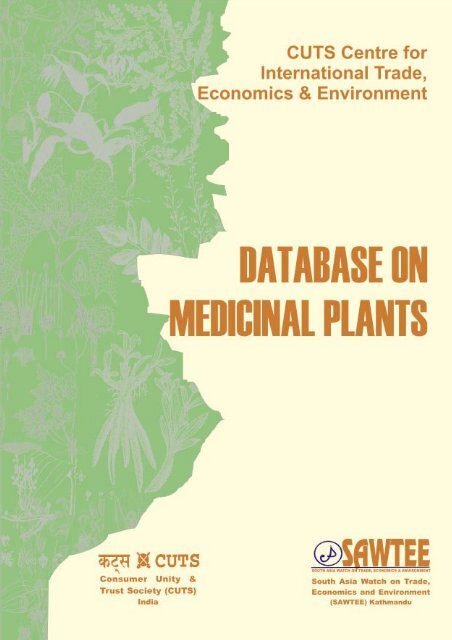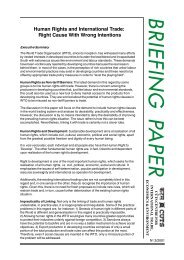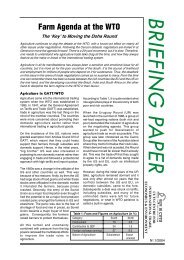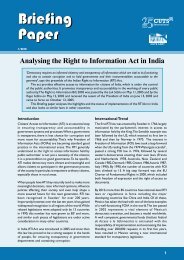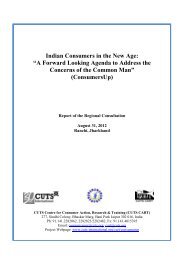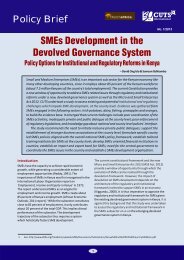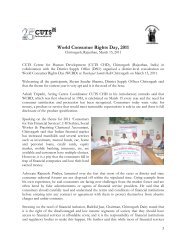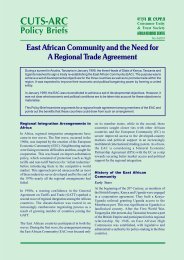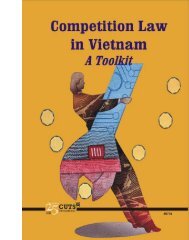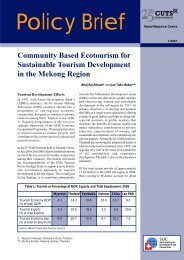Database on Medicinal Plants / 1 - Consumer Unity & Trust Society
Database on Medicinal Plants / 1 - Consumer Unity & Trust Society
Database on Medicinal Plants / 1 - Consumer Unity & Trust Society
Create successful ePaper yourself
Turn your PDF publications into a flip-book with our unique Google optimized e-Paper software.
<str<strong>on</strong>g>Database</str<strong>on</strong>g> <strong>on</strong> <strong>Medicinal</strong> <strong>Plants</strong> / 1
DATABASE ONMEDICINAL PLANTS# 0414
DATABASE ON MEDICINAL PLANTSThis Report has been researched and compiled by Dr. Ghayur Alam of the Centre for Sustainable Development,Dehradun for CUTS Centre for Internati<strong>on</strong>al Trade, Ec<strong>on</strong>omics & Envir<strong>on</strong>ment. The opini<strong>on</strong>s expressed in thereport and any errors of fact or interpretati<strong>on</strong> or omissi<strong>on</strong> are the resp<strong>on</strong>sibility of the author, and do notreflect the agreed policy positi<strong>on</strong>s of the publishers.The same has been commented by Prof. Nabinananda Sen, Department of Business Management, Universityof Calcutta and Mr. Pranav Kumar, Policy Analyst, CUTS Centre for Internati<strong>on</strong>al Trade, Ec<strong>on</strong>omics &Envir<strong>on</strong>ment, (CUTS CITEE), JaipurPublished by:CUTS Centre for Internati<strong>on</strong>al Trade, Ec<strong>on</strong>omics & Envir<strong>on</strong>ment3, Suren Tagore Road, Calcutta 700 019, IndiaTelefax: +91-33-2460 1424, Fax: +91-33-2440 7669Email: cutscal@vsnl.com / cuts-calcutta@cuts-internati<strong>on</strong>al.orgWebsite: www.cuts-internati<strong>on</strong>al.orgSupported by:Ford Foundati<strong>on</strong>, New DelhiActi<strong>on</strong> Aid, NepalPrinted by: R. K. Printers, Calcutta 700 024ISBN:81-8257-028-XCopyright: CUTS, 2004The material in this publicati<strong>on</strong> may be reproduced in whole or in part and in any form foreducati<strong>on</strong> or n<strong>on</strong>-profit uses, without special permissi<strong>on</strong> from the copyright holders,provided acknowledgment of the source is made. The publishers would appreciate receivinga copy of any publicati<strong>on</strong>, which uses this publicati<strong>on</strong> as a source.No use of this publicati<strong>on</strong> may be made for resale or other commercial purposes withoutprior written permissi<strong>on</strong> of CUTS & SAWTEE.This Report is made under the Regi<strong>on</strong>al Programme <strong>on</strong> “Farmers’ Right to Livelihood in the HindukushHimalayan Regi<strong>on</strong>” initiated by South Asia Watch <strong>on</strong> Trade, Ec<strong>on</strong>omics & Envir<strong>on</strong>ment (SAWTEE), basedin Kathmandu in associati<strong>on</strong> with its member organisati<strong>on</strong>s including C<strong>on</strong>sumer <strong>Unity</strong> & <strong>Trust</strong> <strong>Society</strong>(CUTS), India.Price: Rs.200 for India /$20 for other countries+packing/ Postage Charges
TABLE OF CONTENTSPreface ............................................................................. ..................................................6Chapter-IIntroducti<strong>on</strong> ..........................................................................................................................8Chapter-2<strong>Medicinal</strong> <strong>Plants</strong> in Himalayan States ................................................................................ 11Chapter-3<str<strong>on</strong>g>Database</str<strong>on</strong>g> of <strong>Medicinal</strong> <strong>Plants</strong> of Arunanchal PradeshHimachal Pradesh Meghalya and Uttaranchal ................................................................... 21Chapter-4C<strong>on</strong>clusi<strong>on</strong>s and Recomendati<strong>on</strong>s .................................................................................... 39Endnote ............................................................................................................................42References ......................................................................................................................44
PREFACEThe ineluctable challenge before the world today is to turn around thewheel of perpetual poverty, hunger, ill health and illiteracy. The UN adoptedMillennium Development Goals “commit the internati<strong>on</strong>al community toan expanded visi<strong>on</strong> of development, <strong>on</strong>e that vigorously promotes humandevelopment as the key to sustaining social and ec<strong>on</strong>omic progress in allcountries”. Needless to say, sustaining ec<strong>on</strong>omic progress is inseparablylinked with sustainable livelihood and attainment of basic necessities oflife. Focus <strong>on</strong> health and food security emerges as the natural corollary.When so much dust is being raised <strong>on</strong> the formulati<strong>on</strong> and implementati<strong>on</strong>of policies to break the chains of poverty, the significance and importance ofmedicinal plants remain largely unaddressed. <strong>Medicinal</strong> plant addressestwin problem of promoting sustainable livelihood and treating numerous illness.<strong>Medicinal</strong> plant, <strong>on</strong> the <strong>on</strong>e hand, can serve as major source of earning tothe indigenous farmer community and <strong>on</strong> the other, it embodies rich repositoryof traditi<strong>on</strong>al medicinal knowledge. The Declarati<strong>on</strong> of the 7th ASEAN HealthMinisters Meeting held <strong>on</strong> 22 April 2004 at Penang, Malysia menti<strong>on</strong>ed thatin “our countries traditi<strong>on</strong>al medicine (TM) as well as complementary andalternative medicine (CAM) are at times the most widely available and affordablesource of health care.”In this era of trade liberalisati<strong>on</strong>, there is increasing c<strong>on</strong>cern aboutprotecting the indigenous medicinal knowledge of the traditi<strong>on</strong>al farmingcommunity of the developing countries. The World Trade Organisati<strong>on</strong>(WTO) agreement <strong>on</strong> TRIPs (Trade Related Aspects of Intellectual PropertyRights) introduced intellectual property rules into the multilateral tradingsystem for the first time. IPRs are legal instruments which provide protecti<strong>on</strong>to inventi<strong>on</strong>s. Types of IPR vary between patent, plant breeders’ rights,copyrights, trademarks etc.However, in many instances rich countries and powerful corporati<strong>on</strong>s havecaptured a disproporti<strong>on</strong>ate share of the benefits of trade where bio-piracyhas c<strong>on</strong>tinuously become a major c<strong>on</strong>cern. It has been found out thatindustrial countries hold 97 percent of patents worldwide, and more than80 percent of patents in developing countries. More than half of the world’smost frequently prescribed drugs are derived from plants or synthetic copiesof plant chemicals. It is estimated that if <strong>on</strong>ly 2 percent royalty were charged<strong>on</strong> genetic resources developed by local innovators in the South, the Northwould owe billi<strong>on</strong>s of dollars in unpaid royalties for medicinal plants. Someplants which indigenous peoples have discovered, cultivated, and used forfood, medicine, and for sacred rituals got patented in the United States,Japan, and Europe. A few examples of these are ayahuasca, quinoa, andsangre de drago in forests of South America; kava in the Pacific; andturmeric and bitter mel<strong>on</strong> in Asia.The importance of traditi<strong>on</strong>al medicinal plants in c<strong>on</strong>servati<strong>on</strong> of biologicaldiversity also merits attenti<strong>on</strong>. The UN Secretary General’s message <strong>on</strong>Internati<strong>on</strong>al Day for Biological Diversity <strong>on</strong> May 22, 2004 reverberatedthis while explaining this year’s theme “Biodiversity: Food, water and Healthfor All” which “underlines biodiversity’s importance in ensuring food securityand ....in protecting wide array of traditi<strong>on</strong>al medicines ....based <strong>on</strong> world’sbiological riches”.6 / <str<strong>on</strong>g>Database</str<strong>on</strong>g> <strong>on</strong> <strong>Medicinal</strong> <strong>Plants</strong>
It is against this backdrop that developing countries need to promote properpolicy mechanism for c<strong>on</strong>servati<strong>on</strong> and promoti<strong>on</strong> of cultivati<strong>on</strong> of medicinalplants. Subsequently arises the need to develop substantial andcomprehensive database of medicinal plants highlighting the properties ofthose species as also to keep a str<strong>on</strong>g vigil <strong>on</strong> endangered species. Thisreport is a diligent and sincere effort to fill in the gap of reliable informati<strong>on</strong><strong>on</strong> the quantity of collecti<strong>on</strong> and cultivati<strong>on</strong> of medicinal plants, theircommercial potential, existing marketing mechanisms and ensurepromoti<strong>on</strong> and c<strong>on</strong>servati<strong>on</strong> and rati<strong>on</strong>al utilisati<strong>on</strong> of medicinal plants.The areas covered under this study are four states of Central and NorthEastern Himalayas in India. The states are Uttaranchal, ArunachalPradesh, Himachal Pradesh and Meghalaya. Chapter I introduces thegrowing importance of medicinal plants in the world ec<strong>on</strong>omy, itsc<strong>on</strong>tributi<strong>on</strong> to livelihood of mountain communities and provides a briefoverview why large number of medicinal plants are threatened with extincti<strong>on</strong>.Chapter II projects the picture of medicinal plants in the Himalyan statesunder study. The factors preventing the mountain farmers in undertakingcultivati<strong>on</strong> of medicinal plants as a source of sustainable livelihood andpromoti<strong>on</strong> and implementati<strong>on</strong> of different government policies for bothcultivati<strong>on</strong> and c<strong>on</strong>servati<strong>on</strong> of medicinal plants are the major issues ofanalysis in this chapter. Detailed descripti<strong>on</strong> of 35 most important medicinalplants found in these states with their medicinal properties are provided inChapter III. The study ends with c<strong>on</strong>clusi<strong>on</strong> and some majorrecommendati<strong>on</strong>s like providing the farmers with better marketing facilities,preparati<strong>on</strong> of comprehensive biodiversity register, facilitating the role ofcivil society by government in strengthening the medicinal plant sectoretc. in Chapter IV.It is sincerely hoped that our efforts in bringing out this treatise would helpthe mountain farmer of the Hindu Kush Himalayan regi<strong>on</strong> in his strivetowards a sustainable livelihood and development and also create anawareness am<strong>on</strong>g the various other stakeholders.<str<strong>on</strong>g>Database</str<strong>on</strong>g> <strong>on</strong> <strong>Medicinal</strong> <strong>Plants</strong> / 7
Chapter - I<strong>Medicinal</strong> <strong>Plants</strong>: Introducti<strong>on</strong>1. Introducti<strong>on</strong>A large number of people in theHimalayan regi<strong>on</strong> derive employmentand income from the collecti<strong>on</strong>,processing and trade of medicinalplants.This study is undertaken with theobjective to fill the gap of reliableinformati<strong>on</strong> <strong>on</strong> the quantity ofcollecti<strong>on</strong> and cultivati<strong>on</strong> ofmedicinal plants, their commercialpotential and analysing the existingmarketing mechanism to promotecommercial cultivati<strong>on</strong> of medicinalplants.<strong>Medicinal</strong> plants are an important source of raw material for traditi<strong>on</strong>almedicines and a large number of people derive employment and incomefrom the collecti<strong>on</strong>, processing and trade of these plants. With the sharprise in popularity of traditi<strong>on</strong>al medicine, the ec<strong>on</strong>omic importance of theseplants has increased enormously. The role of medicinal plants is particularlyimportant in the Himalayan regi<strong>on</strong>. These areas are richly endowed with alarge variety of plant species, many of which have medicinal properties. Alarge proporti<strong>on</strong> of the rural populati<strong>on</strong> in these areas depends <strong>on</strong> locallyavailable medicinal plants to meet their health care requirements.Furthermore, the collecti<strong>on</strong> and marketing of these plants provide animportant source of income for communities living in the mountain areas.Unfortunately, the increase in demand has also increased the threat ofdepleti<strong>on</strong>, as many of these plants are largely collected from the wild.While the importance of medicinal plants is widely accepted, there is aserious lack of comprehensive informati<strong>on</strong> <strong>on</strong> the ec<strong>on</strong>omically importantand threatened species in the Himalayan regi<strong>on</strong>. Similarly, while the StateGovernments have a number of policies to promote c<strong>on</strong>servati<strong>on</strong> andcultivati<strong>on</strong>, there is little informati<strong>on</strong> <strong>on</strong> the effectiveness of these policies.This study is undertaken with the objective to fill the gap of reliableinformati<strong>on</strong> <strong>on</strong> the quantity of collecti<strong>on</strong> and cultivati<strong>on</strong> of medicinal plants,their commercial potential and analysing the existing marketing mechanismto promote commercial cultivati<strong>on</strong> of medicinal plants. It examines theseissues in four Himalayan states: Uttaranchal, Himachal Pradesh, ArunachalPradesh and Meghalaya.The study is based <strong>on</strong> sec<strong>on</strong>dary sources, which include books, papersin technical journals, newspapers and government reports. This report,which is based <strong>on</strong> the findings of the study, has four chapters. Chapter 1c<strong>on</strong>tinues with a brief descripti<strong>on</strong> of the issue of c<strong>on</strong>servati<strong>on</strong> of medicinalplants and their role in providing livelihood opportunities. Chapter II discussesthe status of medicinal plants and government policies in these states.Chapter III c<strong>on</strong>tains a database <strong>on</strong> the 35 most important species found inthese states. The choice of these species has been made <strong>on</strong> the basis ofenvir<strong>on</strong>mental c<strong>on</strong>cerns and their potential to generate income throughcultivati<strong>on</strong>. The c<strong>on</strong>clusi<strong>on</strong>s and recommendati<strong>on</strong>s are presented inChapter IV.2. <strong>Medicinal</strong> <strong>Plants</strong>: Their Growing ImportanceA large proporti<strong>on</strong> of the world’s populati<strong>on</strong> depends <strong>on</strong> traditi<strong>on</strong>al medicineto meet its health needs. According to estimates, the proporti<strong>on</strong> of theworld’s populati<strong>on</strong> using traditi<strong>on</strong>al medicine ranges between 70-80percent. 1, 2 Furthermore, the popularity of traditi<strong>on</strong>al medicine in developedcountries has grown swiftly in recent years. For example, in Europe andNorth America, the sector has grown at 10-20 percent annually during1990s. 3 Traditi<strong>on</strong>al medicine primarily depends <strong>on</strong> medicinal plants for8 / <str<strong>on</strong>g>Database</str<strong>on</strong>g> <strong>on</strong> <strong>Medicinal</strong> <strong>Plants</strong>
aw material. Worldwide a huge number of plant species is used to providethe raw materials needed by the various systems of traditi<strong>on</strong>al medicine.China and India al<strong>on</strong>e use thousands of plant species. 4The market of traditi<strong>on</strong>al systems ofmedicine in India is estimated to beabout Rs. 4000 crores. The overalldemand for medicinal plants isexpected to increase at about 15 to 16percent between 2002 and 2005.In additi<strong>on</strong> to the domestic market,there is a large and expandinginternati<strong>on</strong>al trade in medicinalplants. About 2500 species ofmedicinal plants are traded in theinternati<strong>on</strong>al market.With the revival of Indian traditi<strong>on</strong>al medicinal systems, the domesticdemand for medicinal plants has seen a rapid increase. The market oftraditi<strong>on</strong>al systems of medicine in India is estimated to be about Rs. 4000crores. The Ayurvedicdrug market al<strong>on</strong>e accounts for about Rs. 3500crores. Furthermore, the Indian market for Ayurvedic medicines isestimated to be expanding at 20 percent annually. 6 Over <strong>on</strong>e and a halfmilli<strong>on</strong> practiti<strong>on</strong>ers of the Indian System of Medicine in the oral and codifiedstreams use medicinal plants in preventive and curative applicati<strong>on</strong>s. Thereare estimated to be over 7800 manufacturing units in India. In additi<strong>on</strong>,there is a large and growing market for food supplements and cosmetics.The overall demand for medicinal plants is expected to increase at about15 to 16 percent between 2002 and 2005. 7In additi<strong>on</strong> to the domestic market, there is a large and expandinginternati<strong>on</strong>al trade in medicinal plants. It is estimated that about 2500species of medicinal plants are traded in the internati<strong>on</strong>al market. 8 Anaverage of 400,000 t<strong>on</strong>nes of medicinal plants, valued at $1.2 bn , wereestimated to be traded annually during 1990s. 9 The main markets includeEurope, North America and Asia. Europe, which accounts for about 50percent of the world market, is the largest. 10 The three leading exportingcountries are China, India and Germany. 11 India’s export of medicinal andherbal plants is expected to grow from about Rs. 446 cr in year 2000 toRs.3000 cr annually by 2005. 123. C<strong>on</strong>servati<strong>on</strong>The rising commercial demand forherbal drugs and dependence <strong>on</strong>material harvested from the wild, hasled to the rapid depleti<strong>on</strong> of anumber of medicinal plant species.IUCN Red List of Threatened Speciesmenti<strong>on</strong>s more than 300 plant species,of which a large number aremedicinal plants, are threatened withextincti<strong>on</strong>.A large proporti<strong>on</strong> of medicinal plants is collected from the wild. 13 In mostof the countries, the proporti<strong>on</strong> of collected material ranges between 70-99 percent. 14 The rising commercial demand for herbal drugs anddependence <strong>on</strong> material harvested from the wild, has led to the rapiddepleti<strong>on</strong> of a number of medicinal plant species. 15 As a result, a largeand increasing number of medicinal plant species are threatened withextincti<strong>on</strong>. For example, according to the Internati<strong>on</strong>al Uni<strong>on</strong> forC<strong>on</strong>servati<strong>on</strong> of Nature and Natural Resources (IUCN) 16 Red List ofThreatened Species, more than 300 plant species, of which a large numberare medicinal plants, are threatened with extincti<strong>on</strong>. This is for a numberof reas<strong>on</strong>s:* N<strong>on</strong>-sustainable harvesting by plant collectors has resulted in thedepleti<strong>on</strong> of many medicinal species. N<strong>on</strong>-destructive, low-intensitycollecti<strong>on</strong> practices have often been replaced by destructive harvestingpractices.* There has been a steady decline in the use of traditi<strong>on</strong>al knowledgeand medicinal plants by the local communities. As a result, the interestof these communities in c<strong>on</strong>servati<strong>on</strong> has declined.* There has also been a shift from local use of medicinal plants tocommercial sale. With the improvement in transportati<strong>on</strong> networks,remote forest areas have become increasingly accessible to outsidetraders. Also, there has been a large increase in the internati<strong>on</strong>aldemand for medicinal plants. As a result, large volumes of commerciallyimportant species are being harvested bey<strong>on</strong>d sustainable levels.* The marketing chains are l<strong>on</strong>g. As the number of agents involvedbetween the collecti<strong>on</strong> of plants and their final sale to the user industry/c<strong>on</strong>sumers is large, the prices paid to the collectors are low. This<str<strong>on</strong>g>Database</str<strong>on</strong>g> <strong>on</strong> <strong>Medicinal</strong> <strong>Plants</strong> / 9
forces them to over-harvest the material to supplement their income.For example, in India, the difference between the prices paid tocollectors and the final market prices ranges between 50 percent-255percent. 17 In Mexico, medicinal plant collectors receive <strong>on</strong>ly 6 percentof the final market price. 18The c<strong>on</strong>servati<strong>on</strong> of medicinal plantsis vitally important for themaintenance of biodiversity and thepreservati<strong>on</strong> of indigenousknowledge. Two ways of c<strong>on</strong>servati<strong>on</strong>of medicinal plants - in situ and exsitu c<strong>on</strong>servati<strong>on</strong>are worthmenti<strong>on</strong>ing here.Current c<strong>on</strong>servati<strong>on</strong> efforts are notenough to ensure the survival of somethreatened species. This wouldrequire strict enforcement ofenvir<strong>on</strong>mental regulati<strong>on</strong>s.A large number of people living inthe mountain areas depend <strong>on</strong> thesale of medicinal plant, collectedfrom the wild, for their livelihood. Aslarge scale collecti<strong>on</strong> can put extremepressure <strong>on</strong> resources, there shouldbe policies to promote the cultivati<strong>on</strong>of medicinal plants.As the material collected from thewild is available at low prices,there is little ec<strong>on</strong>omic incentive forfarmers to take up the cultivati<strong>on</strong>of medicinal plants.It is clear that the c<strong>on</strong>servati<strong>on</strong> of medicinal plants is vitally important forthe maintenance of biodiversity and the preservati<strong>on</strong> of indigenousknowledge. 19 Broadly speaking, two ways of c<strong>on</strong>servati<strong>on</strong> of medicinalplants - in situ and ex situ c<strong>on</strong>servati<strong>on</strong> are worth menti<strong>on</strong>ing here. The‘in-situ’ c<strong>on</strong>servati<strong>on</strong> refers to the site c<strong>on</strong>servati<strong>on</strong> wherein a wild speciesor stock of a biological community is protected and preserved in its naturalhabitat (envir<strong>on</strong>ment). This implies promoting cultivati<strong>on</strong> process inprotected areas. C<strong>on</strong>servati<strong>on</strong> of medicinal plants can also be accomplishedby the ex-situ i.e. outside natural habitat by cultivating and maintainingplants in botanic gardens parks, other suitable sites, l<strong>on</strong>g term preservati<strong>on</strong>of plant propagules in gene banks (seed bank, pollen bank, DNA libraries,etc.) etc.However, it must be pointed out that current c<strong>on</strong>servati<strong>on</strong> efforts are notenough to ensure the survival of some threatened species. This wouldrequire strict enforcement of envir<strong>on</strong>mental regulati<strong>on</strong>s. 20 Furthermore,cultivati<strong>on</strong> could also provide large opportunities of livelihood through incomeand employment generati<strong>on</strong>.4. C<strong>on</strong>tributi<strong>on</strong> to Livelihood<strong>Medicinal</strong> plants and associated knowledge are an integral part of themountain communities’ life. They play a vital role in these communities’holistic approach to health and well being. Furthermore, they also providean important source of income. A large number of people living in themountain areas depend <strong>on</strong> the sale of medicinal plants for their livelihood.A very large proporti<strong>on</strong> of these plants are collected from the wild. There isan increasing c<strong>on</strong>cern that, as large scale collecti<strong>on</strong> can put extremepressure <strong>on</strong> resources, this practice is not sustainable, It is felt, therefore,that the cultivati<strong>on</strong> of species that are in large demand could provide analternative source of livelihood to farmers in these areas. Many countries,including India have policies to promote the cultivati<strong>on</strong> of medicinal plants.However, globally <strong>on</strong>ly a handful of species are being cultivated <strong>on</strong> a largescale. Furthermore, the process of cultivati<strong>on</strong>, in many cases, does notinclude plants having high global demand. 21 Even in China, where thecultivati<strong>on</strong> of medicinal plants is the largest, <strong>on</strong>ly 100-250 species arebeing cultivated <strong>on</strong> a large scale. 22 More than 80percent of the medicinalplants used in China come from wild sources. 23 In Europe, <strong>on</strong>ly 130-140of the 1200-1300 species of native medicinal plants are derivedpredominantly from cultivati<strong>on</strong>. 24While there is great potential in the cultivati<strong>on</strong> of medicinal plants, it islimited by a number of factors. The most important of these, perhaps, isthe downward pressure <strong>on</strong> prices exerted by large- scale collecti<strong>on</strong> fromthe wild. As the material collected from the wild is available at low prices,there is little ec<strong>on</strong>omic incentive for farmers to take up the cultivati<strong>on</strong> ofmedicinal plants. Other reas<strong>on</strong>s include lack of cultivati<strong>on</strong> technology,shortage of planting material, l<strong>on</strong>g gestati<strong>on</strong> periods and lack of marketinginfrastructure in the remote areas.10 / <str<strong>on</strong>g>Database</str<strong>on</strong>g> <strong>on</strong> <strong>Medicinal</strong> <strong>Plants</strong>
Chapter - II<strong>Medicinal</strong> <strong>Plants</strong> in the Himalayan States1. Introducti<strong>on</strong>More than 8000 species of wild plantsare known to be usedin India for the treatmentof various health problems.Although the Himalayan regi<strong>on</strong>occupies <strong>on</strong>ly 15 percent of thecountry’s geographical area, itaccounts for about 30 percent of theendemic species found in the Indiansub-c<strong>on</strong>tinent.<strong>Medicinal</strong> plants provide asignificant source of income for therural poor in India. The c<strong>on</strong>tributi<strong>on</strong>of medicinal plants to rural income isparticularly important in tribal beltsand in the Himalayan regi<strong>on</strong>.Many people in the Himalayanregi<strong>on</strong> use medicinal plants andassociated knowledge to treat avariety of ailments. The Bhotiapeople of the Central Himalayas useover 150 different medicinal plants totreat more than 105 combinati<strong>on</strong>s ofdiseases.India has a rich diversity of medicinal plants; more than 8000 species ofwild plants are known to be used in India for the treatment of varioushealth problems. 25 The Himalayan regi<strong>on</strong> is particularly well endowed withmedicinal plant species. 26 This is largely because of the diverse agro-climaticc<strong>on</strong>diti<strong>on</strong>s which exist in the area. These vary from dry deciduous forestsand alpine meadows in the north-west, to rain forests in the north-east.Although the Himalayan regi<strong>on</strong> occupies <strong>on</strong>ly 15 percent of the country’sgeographical area, it accounts for about 30 percent of the endemic speciesfound in the Indian sub-c<strong>on</strong>tinent. 27 Moreover, the medicinal plants found inthe Himalayan areas include species of particularly high medicinal value. 28Comm<strong>on</strong> with the rest of the Himalayan regi<strong>on</strong>, the states underc<strong>on</strong>siderati<strong>on</strong> have a large variety of medicinal plants. For example,Himachal Pradesh has about 3,000 plant species of which almost 500have medicinal properties. Arunachal Pradesh is also known to have over500 species of medicinal plants. Uttaranchal and Meghalaya are alsoknown to have a large number of medicinal plant species.<strong>Medicinal</strong> plants provide a significant source of income for the rural poor inIndia. According to <strong>on</strong>e estimate, about 50 mn people rely <strong>on</strong> n<strong>on</strong>-timberforest products (NTFP), the most important of these being medicinalplants. 29 The collecti<strong>on</strong> and processing of medicinal plants c<strong>on</strong>tribute toat least 35 mn workdays of employment annually. 30 The c<strong>on</strong>tributi<strong>on</strong> ofmedicinal plants to rural income is particularly important in tribal belts andthe Himalayan regi<strong>on</strong>. This is clearly shown by the example of the GreatHimalayan Nati<strong>on</strong>al Park in the Kulu valley. Approximately 11,000 peoplelive in a five-km wide belt around the Park. As other opti<strong>on</strong>s of livelihoodare limited, the collecti<strong>on</strong> of medicinal plants provides a vital source ofincome for these people. 31 The combinati<strong>on</strong> of guchhi and medicinal herbsales c<strong>on</strong>tributes an average income of over Rs. 10,000 per family in 1997for villages around the park. 32Furthermore, many people in the area depend <strong>on</strong> traditi<strong>on</strong>al knowledge,local healers and medicinal plants to meet their health needs. They usethese plants and associated knowledge to treat a variety of ailments. Forexample, the Bhotia people, living in the high altitude areas of the CentralHimalayas, use over 150 different medicinal plants to treat more than 105combinati<strong>on</strong>s of diseases 33 .Though India has a rich biodiversity, the growing demand is putting a heavystrain <strong>on</strong> the existing resources. The issue of medicinal plant involvestremendous c<strong>on</strong>temporary relevance because it can <strong>on</strong> <strong>on</strong>e hand ensurehealth security to milli<strong>on</strong>s of people and <strong>on</strong> the other hand it can providenew and safe herbal drugs to the entire world.2. Collecti<strong>on</strong><str<strong>on</strong>g>Database</str<strong>on</strong>g> <strong>on</strong> <strong>Medicinal</strong> <strong>Plants</strong> / 11
The large increase in the domesticand global demand for medicinalplants has put extra pressure <strong>on</strong>forest resources. Both the intensityand durati<strong>on</strong> of collecti<strong>on</strong> hasrecently increased resulting indepleti<strong>on</strong> of forest resources.How to break the hold of c<strong>on</strong>tractorsover collecti<strong>on</strong> of medicinal plantsc<strong>on</strong>tinues to be an importantchallenge.To reduce the role of c<strong>on</strong>tractors incollecti<strong>on</strong> in Uttaranchal the c<strong>on</strong>tractto collect is now given <strong>on</strong>ly to villagecommunity organisati<strong>on</strong>s, called“samooh”.As menti<strong>on</strong>ed earlier, a large proporti<strong>on</strong> of medicinal plants are collectedfrom the wild. This is true for the states under study, where up to 90percent of the material is extracted from the wild. 34 The large increase inthe domestic and global demand for medicinal plants has put extra pressure<strong>on</strong> forest resources. Reports show that both the intensity and durati<strong>on</strong> ofcollecti<strong>on</strong> has recently increased. For example, the annual period ofcollecti<strong>on</strong> in the Gori valley of Pithoragarh district has increased from 2m<strong>on</strong>ths to 5 m<strong>on</strong>ths. 35 Similarly, farmers in Johar valley in Uttaranchalreport that because of depleti<strong>on</strong>, the volume <strong>on</strong>e pers<strong>on</strong> can collect hasdeclined significantly in recent years. According to <strong>on</strong>e collector in thePithoragarh district of Uttaranchal, earlier they used to collect about 200grams of dry Atish (Ac<strong>on</strong>itum heterophyllum) in <strong>on</strong>e day; now they do notget more than 70-100 grams.The issue of exercising str<strong>on</strong>g c<strong>on</strong>trol of c<strong>on</strong>tractors and middleman overthe collectors of medicinal plants deserve particular attenti<strong>on</strong>. An importantreas<strong>on</strong> being the collectors’ dependence <strong>on</strong> loans and marketing expertise.As most collectors are poor, they need to borrow from the c<strong>on</strong>tractors.This keeps the collectors tied to the local c<strong>on</strong>tractors. This practice iswidespread, and how to break the hold of c<strong>on</strong>tractors over collecti<strong>on</strong> ofmedicinal plants c<strong>on</strong>tinues to be an important challenge.There have been recent attempts to reduce the role of c<strong>on</strong>tractors incollecti<strong>on</strong>. For example, in Uttaranchal the c<strong>on</strong>tract to collect is now given<strong>on</strong>ly to village community organisati<strong>on</strong>s, called “samooh”. Unfortunately,the c<strong>on</strong>tractors have set up their own “samaoohs”. This has enabled themto maintain their c<strong>on</strong>trol over collecti<strong>on</strong> activities.In the states under study the local c<strong>on</strong>tractors organise most of thecollecti<strong>on</strong> of medicinal plants. The collectors are either wage labourers orfarmers with small land-holdings. There is a general feeling that this system,which depends <strong>on</strong> c<strong>on</strong>tractors and sub-c<strong>on</strong>tractors, c<strong>on</strong>tributes to bothexcessive and illegal collecti<strong>on</strong>. The system allows them to market illegallycollected material with legal material. A recent study carried out by CECI-India (affiliated to the Centre for Internati<strong>on</strong>al Studies and Cooperati<strong>on</strong>,Canada 36 , indicated that from a single district of Pithoragarh in Uttaranchal,more than 1300 t<strong>on</strong>s of medicinal and aromatic plants (MAPs) are collectedand traded annually, most of them illegally.Large-scale collecti<strong>on</strong> has led to a significant depleti<strong>on</strong> of important speciesin some areas. There is a serious threat to a number of medicinal plantsbecause of over exploitati<strong>on</strong>. Seventeen species found in the Himalayanregi<strong>on</strong> are listed in the Red Data Book of India. 373. Cultivati<strong>on</strong>Additi<strong>on</strong>al supply of medicinal plantsthrough cultivati<strong>on</strong> can also reducepressure <strong>on</strong> wild resources, thusc<strong>on</strong>tributing to c<strong>on</strong>servati<strong>on</strong> ofbiodiversity.Cultivati<strong>on</strong> of medicinal plants canbe more profitable for farmers thanthe cash crops being grown currently.12 / <str<strong>on</strong>g>Database</str<strong>on</strong>g> <strong>on</strong> <strong>Medicinal</strong> <strong>Plants</strong>Cultivati<strong>on</strong> of medicinal plants has to be encouraged for meeting the futureneeds. The cultivati<strong>on</strong> of medicinal plants could provide farmers with anattractive opportunity to increase their incomes. The additi<strong>on</strong>al supply ofmedicinal plants through cultivati<strong>on</strong> can also reduce pressure <strong>on</strong> wildresources, thus c<strong>on</strong>tributing to c<strong>on</strong>servati<strong>on</strong> of biodiversity.The data <strong>on</strong> the cost of cultivati<strong>on</strong> of medicinal plants is limited. However,the available data suggests that the cultivati<strong>on</strong> of medicinal plants can bemore profitable for farmers than the cash crops being grown currently. Inthe following table, the comparative costs for cultivati<strong>on</strong> and incomes fromkutki (Picrorhiza Kurrooa) and traditi<strong>on</strong>al cash crops of farmers inUttaranchal are shown. These figures clearly highlight the ec<strong>on</strong>omicadvantages of the cultivati<strong>on</strong> of medicinal plants.Table-I
Comparative cost-benefit analysis (per acre) of traditi<strong>on</strong>al cash crops(potato, rajma) and Kutki cultivati<strong>on</strong> (after three years producti<strong>on</strong>) atGheshe (Uttaranchal)Crop Cost of cultivati<strong>on</strong> Market Yield Gross Net profit(in Rs) price income (Rs)(Rs / kg)(Rs)1. Potato Seed cost 1,800 5 90 qts 45,000 12,600Labour cost 3,600Manure cost 3,000Maintenance cost 1,500Transport cost 22,500Total cost 32,4002. Rajma Seed cost 1,875 25 6 qts 15,000 5,325Labour cost 3,000Manure cost 3,000Maintenance cost 1,500Transport cost 300Total cost 9,6753. Kutki Seed cost 2,591 250 4.42 qts 110,500 88,284Field preparati<strong>on</strong> cost 8,000Manure cost 4,500Maintenance cost 5,000Harvesting/packing 1,000Transport cost 1,125Total cost 22,216Notes:1. Kutki calculati<strong>on</strong>s as per Nautiyal et al ( 2001) while taking the presentmarket rate of Rs 250/kg. Data for potato and Rajma are <strong>on</strong> the basis of asocio-ec<strong>on</strong>omic survey d<strong>on</strong>e by HAPPRC.2. Kukti data are from low altitude area and from a few farmers <strong>on</strong>ly, whohave widely differing results. The figures given here are the averages.Source: Nautiyal M. C and B. P. Nautiyal, “Collaborati<strong>on</strong> Between Farmers,Research Instituti<strong>on</strong>s and Industry: Experiences of Picrorhiza KurrooaCultivati<strong>on</strong> at Gheshe Village in Chamoli District, Uttaranchal”, Paper presentedat Expert C<strong>on</strong>sultati<strong>on</strong> <strong>on</strong> <strong>Medicinal</strong> <strong>Plants</strong>: Strengthening the Sector inUttaranchal, October 30-31, 2003, Dehradun, UttaranchalBoth the Central and Stategovernments have policies topromote the cultivati<strong>on</strong> of medicinalplants. However, in spite of theimportance given to it, <strong>on</strong>ly a smallamount of medicinal plants’cultivati<strong>on</strong> is taking place in India.The informati<strong>on</strong> published by the Nati<strong>on</strong>al <strong>Medicinal</strong> Plant Board also showscomparatively high rate of profitability. For example, the expenditure andreturns <strong>on</strong> the cultivati<strong>on</strong> of kuth (Sassurea costus) and Sarpagandha(Rauwolfia serpentina) are reported to be Rs. 14,000 and Rs. 45,000 perhectare respectively. The farmers can expect to earn about Rs. 31,000per hectare from the cultivati<strong>on</strong> of these species. 38Both the Central and State governments have policies to promote thecultivati<strong>on</strong> of medicinal plants. However, in spite of the importance given toit, <strong>on</strong>ly a small amount of medicinal plants’ cultivati<strong>on</strong> is taking place inIndia. Out of more than 400 major plant species used for the producti<strong>on</strong> ofmedicine by the Indian herbal industry, fewer than 20 species are currentlyunder cultivati<strong>on</strong> in different parts of the country. 39The situati<strong>on</strong> is no different in the Himalayan states under c<strong>on</strong>siderati<strong>on</strong>.<str<strong>on</strong>g>Database</str<strong>on</strong>g> <strong>on</strong> <strong>Medicinal</strong> <strong>Plants</strong> / 13
There is no large-scale cultivati<strong>on</strong> ofmedicinal plants in the states understudy and both the number of farmersand the size of cultivati<strong>on</strong> are small.Our research shows that there is no large-scale cultivati<strong>on</strong> of medicinalplants in these states, and both the number of farmers and the size ofcultivati<strong>on</strong> are small. For example, in the Chamoli and Pithoragarh districtsof Uttaranchal, cultivati<strong>on</strong> was found to be restricted to a few villages inthe Niti and Johar valleys. Even in these places cultivati<strong>on</strong> is being carriedout <strong>on</strong> small plots near the farmers’ houses. The size of these plots rangesbetween 2-4 nalis <strong>on</strong>ly. This is the general pattern in the area.There are a number of reas<strong>on</strong>s that prevent farmers from undertaking thecultivati<strong>on</strong> of medicinal plants. These include the following: 401. Ec<strong>on</strong>omic FactorsThe technologies for the cultivati<strong>on</strong> ofmedicinal plants are yet to be tried <strong>on</strong>a large scale, and their success is yetto be proven. As the farmers do nothave experience of these techniques,they face risks c<strong>on</strong>cerning both thequantity and quality of producti<strong>on</strong>.Most of the high value medicinalplants grown in high altitude areascan be harvested <strong>on</strong>ly after threeyears or more.The low cost of collecti<strong>on</strong> (both legaland illegal) puts a downwardpressure <strong>on</strong> the price, makingcultivati<strong>on</strong> unattractive. The primaryproducers also have comparativelylow bargaining power.As l<strong>on</strong>g as large-scale collecti<strong>on</strong>c<strong>on</strong>tinues and improved cultivati<strong>on</strong>technologies are not transferred tofarmers, the latter may be reluctantto undertake the cultivati<strong>on</strong> ofmedicinal plants.a) High Risk. Farmers interested in the cultivati<strong>on</strong> of medicinal plants facea number of risks. The technologies for the cultivati<strong>on</strong> of these plantsare yet to be tried <strong>on</strong> a large scale, and their success is yet to beproven. As the farmers do not have experience of these techniques,they face risks c<strong>on</strong>cerning both the quantity and quality of producti<strong>on</strong>.Also, the demand for and prices of medicinal plants experience a largedegree of fluctuati<strong>on</strong>, thereby increasing farmers’ risk.Most farmers report that due to the high risk involved, they are reluctantto c<strong>on</strong>vert large parts of their land to medicinal plants. The tendencyis either to c<strong>on</strong>vert a small area or use fallow land. For example,research shows that the size of plots <strong>on</strong> which medicinal plants arecultivated in the Johar valley ranges between 2-4 nalis <strong>on</strong>ly. As amajority of farmers in the mountain areas have small land-holdings,they are averse to c<strong>on</strong>verting large porti<strong>on</strong>s to medicinal plants.b) L<strong>on</strong>g Gestati<strong>on</strong> Period. Many medicinal plants can be harvested<strong>on</strong>ly after three years or more. This is particularly true of the highvalue plants grown in high altitude areas. Most farmers are not preparedto wait such a l<strong>on</strong>g time for returns. While some of the plants grownin low altitude have low gestati<strong>on</strong> period, they fetch low price in themarket.c) Low Prices. Many farmers feel that the prices they receive do notcompensate for the difficulties and uncertainties involved in thecultivati<strong>on</strong> of medicinal plants. The prices are low for two importantreas<strong>on</strong>s. Firstly, the low cost of collecti<strong>on</strong> (both legal and illegal) putsa downward pressure <strong>on</strong> the price, making cultivati<strong>on</strong> unattractive.Sec<strong>on</strong>dly, the primary producers have comparatively low bargainingpower.Although accurate informati<strong>on</strong> <strong>on</strong> the cost of cultivati<strong>on</strong> is not available,there is a general feeling that it is higher than the cost of collecti<strong>on</strong>.Cultivati<strong>on</strong> requires land, labour, planting material and other inputs. Also,the returns from cultivati<strong>on</strong> in many cases are available <strong>on</strong>ly after 3-4years. On the other hand, the cost of collecti<strong>on</strong> mainly c<strong>on</strong>stitutes oflabour and the returns are available within a few m<strong>on</strong>ths. Sec<strong>on</strong>dly, as thecultivati<strong>on</strong> of medicinal plants is a comparatively new activity, the yieldsare low. Therefore, as l<strong>on</strong>g as large-scale collecti<strong>on</strong> c<strong>on</strong>tinues and improvedcultivati<strong>on</strong> technologies are not transferred to farmers, the latter may bereluctant to undertake the cultivati<strong>on</strong> of medicinal plants. 41Increased competiti<strong>on</strong> from imports has also led to a decline of prices.With the increased liberalisati<strong>on</strong> of import policies, the import of medicinalplants has increased significantly. 42 In many instances, this has resultedin the lowering of prices to such an extent that local cultivati<strong>on</strong> has becomeec<strong>on</strong>omically n<strong>on</strong>-viable. For example, the cultivati<strong>on</strong> of Kala Zira (Carum14 / <str<strong>on</strong>g>Database</str<strong>on</strong>g> <strong>on</strong> <strong>Medicinal</strong> <strong>Plants</strong>
In many instances, increasedcompetiti<strong>on</strong> from imports has alsoresulted in the lowering of prices tosuch an extent that local cultivati<strong>on</strong>has become ec<strong>on</strong>omically n<strong>on</strong>-viable.carvi) has been seriously affected by its imports in large quantities fromChina. The price has come down from Rs 230/kg in 2000 to Rs150/kg in2003. Many farmers in Johar Valley of Uttaranchal, who grew kala zira <strong>on</strong>large scale in the past, have stopped its cultivati<strong>on</strong>.2. Lack of Technological SupportSystematic cultivati<strong>on</strong> of manymedicinal plants needs speciesspecificcultural practices andagr<strong>on</strong>omical requirements dependent<strong>on</strong> soil, water and climaticc<strong>on</strong>diti<strong>on</strong>s.Systematic cultivati<strong>on</strong> of many medicinal plants needs specific culturalpractices and agr<strong>on</strong>omical requirements. 43 These are species-specific andare dependent <strong>on</strong> soil, water and climatic c<strong>on</strong>diti<strong>on</strong>s. Hence research anddevelopment work has to be d<strong>on</strong>e to formulate good agricultural practiceswhich will include appropriate selecti<strong>on</strong> and identificati<strong>on</strong>, propagati<strong>on</strong>methods, cultivati<strong>on</strong> techniques, harvesting, stepwise quality c<strong>on</strong>trol ofraw material up to the processing stage, post-harvest treatment, storageand safety.Farmers face serious difficulties, as they have no experience in cultivatingmedicinal plants. There is a clear need for the development of technologiesrelated to cultivati<strong>on</strong>, harvesting, storage, transportati<strong>on</strong> and quality c<strong>on</strong>trol.Although many research institutes are doing research <strong>on</strong> medicinal plants,their work has c<strong>on</strong>tributed little to farmers. This is for a number of reas<strong>on</strong>s:It would be better if the researchefforts <strong>on</strong> medicinal plants werecoordinated by <strong>on</strong>e agency, withclose collaborati<strong>on</strong> am<strong>on</strong>g theresearch institutes.1. Sub-optimal use of resources. The resources available for research<strong>on</strong> medicinal plants are distributed too thinly, as research is beingd<strong>on</strong>e <strong>on</strong> a large number of species. This creates a situati<strong>on</strong> wheren<strong>on</strong>e of the research work has sufficient resources to achieve success.In order to use resources efficiently, it is important that research isfocused <strong>on</strong> fewer species than now. The efficiency of research hasalso been reduced by lack of collaborati<strong>on</strong> between the variousresearch institutes. It would be better if the research efforts werecoordinated by <strong>on</strong>e agency, with close collaborati<strong>on</strong> am<strong>on</strong>g theresearch institutes.2. Research efforts are focused <strong>on</strong> the development of cultivati<strong>on</strong>technologies. Problems relating to packaging, storage, transportati<strong>on</strong>and quality c<strong>on</strong>trol are largely neglected. As these processes arevitally important for achieving high quality, greater efforts are neededto solve these problems.There is very little <strong>on</strong>-farm researchand farmers’ participati<strong>on</strong> in theresearch process is negligible.The research institutes do not havethe resources and experience toundertake a large-scale diffusi<strong>on</strong> oftechnologies and this gap needs to befilled.3. The linkages between institutes and farmers are weak. Most of theresearch is being d<strong>on</strong>e in laboratories. There is very little <strong>on</strong>-farmresearch and farmers’ participati<strong>on</strong> in the research process isnegligible. This has a number of implicati<strong>on</strong>s. These include: (a) theproblems faced by farmers are not fully reflected in research efforts;(b) researchers are unable to take advantage of farmers’ experience; 44(c) as farmers are not involved in the research process, diffusi<strong>on</strong> oftechnology is hampered.The research institutes do not have the resources and experience toundertake a large-scale diffusi<strong>on</strong> of technologies. This gap needs tobe filled. Institutes also lack resources to train farmers. Only a fewefforts to train farmers have been made. There is also some doubt asto whether the research institutes have sufficient farm experience totrain farmers.4. The linkages between research institutes and industry are weak.Barring a few excepti<strong>on</strong>s, there is no collaborati<strong>on</strong> between researchinstitutes and industry. There is a general lack of appreciati<strong>on</strong> of theadvantages of collaborati<strong>on</strong>. The industry is reluctant to supportresearch, as it is not sure of the commercial returns. The research<str<strong>on</strong>g>Database</str<strong>on</strong>g> <strong>on</strong> <strong>Medicinal</strong> <strong>Plants</strong> / 15
Barring a few excepti<strong>on</strong>s, there is nocollaborati<strong>on</strong> between researchinstitutes and industry.Farmers have complained that theplanting material provided bygovernmental agencies is often ofpoor quality.To improve the situati<strong>on</strong>private sector needs to be involved inthe producti<strong>on</strong> and marketing ofplanting material.priorities of institutes are still largely dictated by academic compulsi<strong>on</strong>sand the pressure of peer groups..5. Research suggests that there is a serious shortage of planting materialto set up cultivati<strong>on</strong> in large areas. Farmers have also complainedthat the planting material provided by governmental agencies is oftenof poor quality. In fact, many of them have lost interest in growingmedicinal plants as they had been given poor material in the past. Toimprove the situati<strong>on</strong> private sector needs to be involved in theproducti<strong>on</strong> and marketing of planting material.6. Presently, the focus of research activities is to develop cultivati<strong>on</strong>technologies for threatened species. The choice of species is notbased <strong>on</strong> the availability of technology and market. It would be betterif species with greater ec<strong>on</strong>omic relevance for a large number of farmerswere also covered by research programmes. Also, research to developmethods of sustainable collecti<strong>on</strong> needs to be given greaterimportance.3. Supply Chain and Market Related ProblemsThe number of actors in the supplychain is large including primarycollectors and producers, localc<strong>on</strong>tractors, local middlemen,regi<strong>on</strong>al wholesale markets etc.The collectors and farmers arecompletely dependent <strong>on</strong> localtraders for the marketing of theirproducts. As there are no opentrading facilities (such as mandis) formedicinal plants.The number of actors in the supply chain is large. These include: primarycollectors and producers, local c<strong>on</strong>tractors, local middlemen, regi<strong>on</strong>alwholesale markets, markets in large centres such as Delhi, Calcutta andAmritsar and specialized suppliers. In almost all cases, the primarycollectors and producers sell to local c<strong>on</strong>tractors and middlemen. Asthey are tied to these agents through debts and other obligati<strong>on</strong>s, theirbargaining power is negligible. Also, as they have <strong>on</strong>ly small amounts tosell, they do not have the opti<strong>on</strong> of selling directly to wholesalers.The marketing of medicinal plants by farmers is <strong>on</strong>e of the central problems.The collectors and farmers are completely dependent <strong>on</strong> local traders forthe marketing of their products. As there are no open trading facilities(such as mandis) for medicinal plants, the market is c<strong>on</strong>trolled by a handfulof traders in the wholesale centres. N<strong>on</strong>e of these centres has more than6-7 traders. This provides them with marked opportunity to fix prices 45 .Primary producers also suffer from the fact that reliable informati<strong>on</strong> <strong>on</strong>demand and prices is not available. C<strong>on</strong>sidering that governmentalagencies and research institutes have little c<strong>on</strong>tact with the industry, thisis not surprising. It was found that in many instances prevailing marketprices were lower than those indicated by official agencies. Furthermore,the official estimates do not take into account large fluctuati<strong>on</strong>s in demand.A survey c<strong>on</strong>ducted in 1997 points out the difference between what theherb gatherers get and the processed material’s worth. One kg of solanumxanthocarpum (kateli)fetches the gatherer Rs 1.5, the wholesaler Rs 7and the exporter Rs 15. The price of the final product that is derived from<strong>on</strong>e kg of the material is worth Rs 1,200. 46As the traders play a crucial role inthe smooth functi<strong>on</strong>ing of the supplychain, it is unlikely that direct sellingto industry could become a practicalopti<strong>on</strong>.Direct selling to industry by groups of farmers is sometimes suggested as<strong>on</strong>e way of reducing the c<strong>on</strong>trol of c<strong>on</strong>tractors and traders. However, asthe traders play a crucial role in the smooth functi<strong>on</strong>ing of the supplychain, it is unlikely that direct selling to industry could become a practicalopti<strong>on</strong>.Here comes up the issue of buy back arrangements wherein corporateand large trading companies enter into arrangements with farmers to supplycrucial farm and management inputs and buy-back the produce, making itadvantageous both for the producer as well as the industry. In the states16 / <str<strong>on</strong>g>Database</str<strong>on</strong>g> <strong>on</strong> <strong>Medicinal</strong> <strong>Plants</strong>
Buy back arrangements imply thatcorporate and large tradingcompanies enter into arrangementswith farmers to supply crucial farmand management inputs and buybackthe produce, making itadvantageous both for the produceras well as the industry.C<strong>on</strong>tract farming and buy-backarrangements provide the <strong>on</strong>lypractical alternatives to exporterswhose customers require tracebility.under study, government is also directly involved in such system andencourages organic cultivati<strong>on</strong> of medicinal plants. It has been suggestedthat buy-back arrangements between farmers and large user companiescould effect increased farmers’ earnings and reduce their risk. Our studyof the supply chain suggests that the current system of purchase is ideallysuited to meeting the industry’s requirements. 47 It is unlikely this will bechanged in favour of direct purchase from farmers. Firms require manyvarieties of raw material, often as many as three to four hundred. Animportant c<strong>on</strong>siderati<strong>on</strong> of their policy is to rati<strong>on</strong>alise purchasing by buyingfrom a limited number of suppliers and large wholesalers. Companieswould find it near impossible to acquire everything they need directly fromfarmers. However, there could be a role for buy back arrangements withlarge traders and exporters.Large traders may be interested in offering buy-back arrangements forspecies which are difficult to obtain, whose supply fluctuates or when anarrangement at a lower than market price can be made. Large exportersmay also find buy-back arrangements attractive in the future, as therequirement of traceability will become increasingly important. At presentit is impossible to trace the origin of any material, as there is littletransparency and documentati<strong>on</strong>. C<strong>on</strong>tract farming and buy-backarrangements provide the <strong>on</strong>ly practical alternatives to exporters whosecustomers require tracebility. However, as it is still possible to exportwithout traceability, the full impact of this trend is yet to be felt in India.4. Government PoliciesThe governments in the Himalayanstates have introduced polices bothto c<strong>on</strong>serve resources in situ and topromote cultivati<strong>on</strong> by farmers tocounter the rapid depleti<strong>on</strong> ofmedicinal plants, caused by theirlarge scale collecti<strong>on</strong> from the wild.The governments in the Himalayan states are seriously c<strong>on</strong>cerned aboutthe rapid depleti<strong>on</strong> of medicinal plants, caused by their large scalecollecti<strong>on</strong> from the wild. They have introduced polices both to c<strong>on</strong>serveresources in situ and to promote cultivati<strong>on</strong> by farmers. In order to checkunsustainable and illegal collecti<strong>on</strong>, the instituti<strong>on</strong>s and mechanismsinvolved in the collecti<strong>on</strong> of medicinal plants from the wild are beingreorganised. Most states have also established State <strong>Medicinal</strong> PlantBoards. These Boards are resp<strong>on</strong>sible for coordinating various activitiesto promote the development of the medicinal plant sector. 48In spite of various measures introduced in the past, government policieshave met with little success in reducing collecti<strong>on</strong> from the wild andpromoting cultivati<strong>on</strong>. As the problem of depleti<strong>on</strong> has c<strong>on</strong>tinued to worsen,there have been efforts to introduce new measures.The new policy measures includegiving greater resp<strong>on</strong>sibility to theForest Departments both to c<strong>on</strong>trolcollecti<strong>on</strong> from the wild and toundertake the marketing of material.The new policy measures include giving greater resp<strong>on</strong>sibility to the ForestDepartments both to c<strong>on</strong>trol collecti<strong>on</strong> from the wild and to undertake themarketing of material. For example, until recently the Bhaishaj Sangh(medicinal plants cooperative) was solely resp<strong>on</strong>sible for overseeing thecollecti<strong>on</strong> of medicinal plants in Uttaranchal. It was said that the c<strong>on</strong>tractorsmostly c<strong>on</strong>trolled the Sangh, and that they misused it by undertakingexcessive and illegal collecti<strong>on</strong>. It was also used to collect species whosecollecti<strong>on</strong> was restricted by the Forest Department of Uttaranchal. TheForest Department will now have greater c<strong>on</strong>trol over the collecti<strong>on</strong> andmarketing of medicinal plants in Uttaranchal.In Himachal Pradesh, policy includes measures to involve local peopleand give powers to panchayats to issue permits to trade, including exportand to species that are not banned. The government hopes that thesewill enforce the traditi<strong>on</strong>al rights of the local communities and checkindiscriminate exploitati<strong>on</strong> of medicinal plants by traders. The Forest<str<strong>on</strong>g>Database</str<strong>on</strong>g> <strong>on</strong> <strong>Medicinal</strong> <strong>Plants</strong> / 17
In Himachal Pradesh, policy includesmeasures to involve local people andgive powers to panchayats to issuepermits to trade, including export andto species that are not banned.In additi<strong>on</strong> to preventing excessivecollecti<strong>on</strong> from the wild, thegovernments of Uttaranchal,Himachal Pradesh and ArunachalPradesh have introduced c<strong>on</strong>cretepolicies to promote cultivati<strong>on</strong>.Uttaranchal government has recentlygiven a number of government farmsto private companies, researchinstitutes and NGOs to carry outlarge- scale cultivati<strong>on</strong> of medicinalplants.The Himachal state government hasstarted promoting ex-situc<strong>on</strong>servati<strong>on</strong> like the setting up of anumber of herbal gardens in thestate.Department will c<strong>on</strong>tinue to regulate the collecti<strong>on</strong> and transit ofendangered species. Out of the 53 species widely used for medicinal andaromatic purposes, the panchayats are allowed to give permits for thetrade of 31 species. Export through the panchayats of the remaining 22species, including the 17 that are endangered will not be allowed. TheDivisi<strong>on</strong>al Forest Officer will be resp<strong>on</strong>sible for granting permissi<strong>on</strong> to exportthese plants. Even in the case of the 31 species, the Forest Departmentcan prevent their collecti<strong>on</strong> and trade if it is felt that there has beenexcessive exploitati<strong>on</strong>. 49In additi<strong>on</strong> to preventing excessive collecti<strong>on</strong> from the wild, the governmentsof Uttaranchal, Himachal Pradesh and Arunachal Pradesh have introducedc<strong>on</strong>crete policies to promote cultivati<strong>on</strong>. These policies are being promotedthrough various government departments, such as the HorticultureDepartment, Forest Department, Department of Rural Development andResearch Institutes. The measures to promote cultivati<strong>on</strong> include:a) Strengthen research and development activitiesb) Providing subsidies and financial support for the purchase of plantingmaterial, land improvement and cultivati<strong>on</strong> of medicinal plantc) Promoti<strong>on</strong>al activities to familiarise farmers with the potential ofmedicinal plants as cash cropsd) Training of farmers to familiarize them with cultivati<strong>on</strong> and postharvestingtechnologiese) Development and diffusi<strong>on</strong> of cultivati<strong>on</strong> and other technologiesf) Setting up of nurseries and other facilities to propagate and deliverplanting material to farmersThe Uttaranchal government has taken a number of initiatives in recentm<strong>on</strong>ths to promote the cultivati<strong>on</strong> of medicinal plants. For example, it hasstrengthened the Herbal Research Development Institute to coordinatevarious activities c<strong>on</strong>cerning medicinal plants in the state. The Institutewill act as the nodal agency for the promoti<strong>on</strong> of the cultivati<strong>on</strong> of medicinalplants. The government is also making efforts to involve the private sectorand n<strong>on</strong> government organisati<strong>on</strong>s (NGOs) in promoti<strong>on</strong> activities. It hasrecently given a number of government farms to private companies, researchinstitutes and NGOs to carry out large- scale cultivati<strong>on</strong> of medicinal plants.It also plans to take steps to increase the availability of technology andplanting materials to farmers. There is emphasis <strong>on</strong> an extensive increasein the number of nurseries, in order to meet the expected growth in demandfor planting material.The Himachal state government has also initiated a number of measuresto promote the cultivati<strong>on</strong> of medicinal plants. These include ex-situc<strong>on</strong>servati<strong>on</strong> like the setting up of a number of herbal gardens in the state.These gardens (called “vanaspati vanas’) will be set up with support fromthe Uni<strong>on</strong> Health Ministry and will cost more than Rs 8 crore. 50 In additi<strong>on</strong>to ex-situ c<strong>on</strong>servati<strong>on</strong>, the gardens will be used to give training to farmersin the growing of medicinal plants as cash crops <strong>on</strong> their land holdings.Herbal gardens are planned in Jogindernagar, Neri in Hamirpur district,Sarivase in Rohru sub-divisi<strong>on</strong> of Shimla district and Batseri in the Sanglavalley of Kinnaur district. 51In additi<strong>on</strong> to the government agencies, research institutes are also engagedin the promoti<strong>on</strong> of cultivati<strong>on</strong> in Himachal Pradesh and also carry outstudies to determine the suitability of various cultivati<strong>on</strong> methods. Aworkshop was held by the G B Pant Institute to examine the cultivati<strong>on</strong> ofendangered medicinal plants in Himachal Pradesh. 52 It identified a numberof species for various regi<strong>on</strong>s of the state depending <strong>on</strong> the climate suitable18 / <str<strong>on</strong>g>Database</str<strong>on</strong>g> <strong>on</strong> <strong>Medicinal</strong> <strong>Plants</strong>
To examine the cultivati<strong>on</strong> ofendangered medicinal plants inHimachal Pradesh, a number ofspecies for various regi<strong>on</strong>s of thestate has been identified depending<strong>on</strong> the climate suitable forcultivati<strong>on</strong>.In Arunachal Pradesh, thegovernment has schemes to trainfarmers in the cultivati<strong>on</strong> ofmedicinal plants which are being runin collaborati<strong>on</strong> with NGOs.In additi<strong>on</strong> to state level researchinstitutes, a number of nati<strong>on</strong>alinstitutes also work <strong>on</strong> the promoti<strong>on</strong>of medicinal plant cultivati<strong>on</strong> in theHimalayan states.The governments of the states understudy have introduced policies topromote both c<strong>on</strong>servati<strong>on</strong> andcultivati<strong>on</strong>. But the problem of poorimplementati<strong>on</strong> c<strong>on</strong>tinues to be amajor bottleneck.for cultivati<strong>on</strong>. These include: Nardostachys Jatamansi for cold deserts,Valeriana Jatamansi for mid altitude, Rauwolfia Serpentina for lower altitudeand Picrorhiza Kurrooa and Ac<strong>on</strong>itum Heterophyllum for high altitude. 53In Arunachal Pradesh, the government has schemes to train farmers inthe cultivati<strong>on</strong> of medicinal plants. These schemes are being run incollaborati<strong>on</strong> with NGOs. The State <strong>Medicinal</strong> Plant Board, which is thecoordinating body, has also produced a number of books <strong>on</strong> the cultivati<strong>on</strong>technology of ec<strong>on</strong>omically important medicinal plants. The State ForestResearch Institute is also involved in the promoti<strong>on</strong> of medicinal plants inArunachal Pradesh. As a result of these efforts, by 2003, about 225 farmershave shown interest in growing medicinal plants 54 . Of these, 47 areregistered with the State <strong>Medicinal</strong> Plant Board. The state has also 28registered traders in medicinal plants. 55In additi<strong>on</strong> to state level research institutes, a number of nati<strong>on</strong>al institutesalso work <strong>on</strong> the promoti<strong>on</strong> of medicinal plant cultivati<strong>on</strong> in the Himalayanstates. These include institutes bel<strong>on</strong>ging to the Council of Scientific andIndustrial Research (CSIR), the Indian Council of Agricultural Research(ICAR) and the Ministry of Envir<strong>on</strong>ment. The important institutes include:Regi<strong>on</strong>al Research Laboratories (RRL), Jorhat, GB Pant Institute ofHimalayan Envir<strong>on</strong>ment and Development, Kosi and Srinagar (Uttaranchal),G.B.Pant Institute of Himalayan Envir<strong>on</strong>ment and Development, Mohal-Kullu (Himachal Pradesh)The state governments under the study have selected a number of medicinalplant species which are being promoted for cultivati<strong>on</strong>. The promoti<strong>on</strong>alpolicies are not specific to individual species but apply to all these species.The list of these species is given in the table (next page).It is clear that the Himalayan states under c<strong>on</strong>siderati<strong>on</strong> are aware of theimportance of medicinal plants and the need to promote their c<strong>on</strong>servati<strong>on</strong>and cultivati<strong>on</strong>. They are also c<strong>on</strong>cerned about the large-scale collecti<strong>on</strong>from the wild, which has already exposed some species to the threat ofextincti<strong>on</strong>. The governments of these states have introduced policies topromote both c<strong>on</strong>servati<strong>on</strong> and cultivati<strong>on</strong>. However, the policies have metwith little success. While a number of banned species c<strong>on</strong>tinue to becollected from the wild illegally, their cultivati<strong>on</strong> has failed to become popular.Some changes in policy are being c<strong>on</strong>sidered to meet this challenge, butthe problem of poor implementati<strong>on</strong> c<strong>on</strong>tinues to be a major bottleneck.Unless the process of policy implementati<strong>on</strong> is improved, it is doubtfulwhether the new measures will be successful.<str<strong>on</strong>g>Database</str<strong>on</strong>g> <strong>on</strong> <strong>Medicinal</strong> <strong>Plants</strong> / 19
Table-IISpecies Being Promoted by State GovernmentsStateArunachal PradeshHimachal PradeshMeghalayaUttaranchalSpecies being promoted for cultivati<strong>on</strong>Ac<strong>on</strong>itum heterophyllumCoptis teetaPicrorhiza kurrooaRauvolfia serpentinaTaxus wallichianaAc<strong>on</strong>itum heterophyllumAcorus calamusAngelica glaucaBerberis aristataNardostrachys jatamansiPicorhiza kurroorCinch<strong>on</strong>a ledgerianaRauvolfia serpentinaSolanum khasianumSwertia chirataTaxus wallichianaAc<strong>on</strong>itum heterophyllumCoptis teetaDactylorhiza hatagireaNardostrachys jatamansiPicrorhiza kurrooaPodophyllum hexandrumRaulfia serpentiaSaussurea costusSwartia chirataTaxus wallichiana20 / <str<strong>on</strong>g>Database</str<strong>on</strong>g> <strong>on</strong> <strong>Medicinal</strong> <strong>Plants</strong>
Chapter - III<str<strong>on</strong>g>Database</str<strong>on</strong>g> of <strong>Medicinal</strong> Plant of Arunachal Pradesh,Himachal Pradesh, Meghalaya and Uttaranchal1. Acacia catechuFamily:Comm<strong>on</strong> name:MimosaceaeKaithPlant parts used-Bark, Heartwood<strong>Medicinal</strong> properties /Uses-1. Melancholia2. C<strong>on</strong>junctivitis3. Haemophilia4. Bitter5. Astringent6. Acrid7. Cooling8. Depurative9. Antiseptic10. Digestive11. AppetiserCultivated or not-wildExtent of availability - Not EndangeredRed Data Book: Not ListedEstimated Domestic Demand (2004-05): NAMarket price: Rs. 37/KgFound in states: All Himalayan StatesDistributi<strong>on</strong>:Native to India, Myanmar, Sri Lanka & East Africa.Comm<strong>on</strong> in Indian forests up to an elevati<strong>on</strong> of 1,500 m.<str<strong>on</strong>g>Database</str<strong>on</strong>g> <strong>on</strong> <strong>Medicinal</strong> <strong>Plants</strong> / 21
2. Ac<strong>on</strong>itum heterophyllumFamily:Comm<strong>on</strong> name:RanunculaceaeAtisPlant parts used- Root, Tubers, Seeds<strong>Medicinal</strong> properties / Uses-1. Antiperiodic2. Anodyne3. Antidiabetic4. Antipyretic in very small doses.5. Narcotic6. Powerful sedative.Cultivated / Wild - BothEstimated Domestic Demand (2004-05): 448.4 t<strong>on</strong>nes per annumMarket price: Rs. 1209 /KgExtent of availability - EndangeredRed Data Book:Found in states:Distributi<strong>on</strong>:ListedUttaranchal, Himachal Pradesh.Comm<strong>on</strong> in the sub alpine and alpine z<strong>on</strong>es ofHimalayas at altitudes between 1,800 - 4,500.3. Acorus calamusFamily: Alliaceae/AraceaeComm<strong>on</strong> name-Gurbach/GurbajPlant parts used- Rhizomes<strong>Medicinal</strong> properties / Uses1. Bitter 6. Diuretic2. Acrid 7. Intellect promoting3. Thermogenic 8. Aromatic4. Emmenagogue 9. Expectorant5. AlexetericEstimated Domestic Demand (2004-05): NAMarket price- Rs. 30 /KgCultivated / Wild -BothExtent of availability - Not EndangeredRed Data Book:Found in states:Distributi<strong>on</strong>:ListedUttaranchal, Himachal PradeshFound throughout the Indian Himalayas up to 6000 mand in Srilanka22 / <str<strong>on</strong>g>Database</str<strong>on</strong>g> <strong>on</strong> <strong>Medicinal</strong> <strong>Plants</strong>
4. Allium sativumFamily:Comm<strong>on</strong> name:Alliaceae/AraceaeJimbu pharanPlant part used - Root<strong>Medicinal</strong> properties / Uses1. Hysteria2. Flatulence3. Sciatica4. Heart disease5. Facial paralysis6. HemiplegiaCultivated / Wild -CultivatedEstimated Domestic Demand (2004-05): NAMarket price: Rs. 32 /kgRed Data Book:Found in states:Distributi<strong>on</strong>:Plant part used- RootListedUttaranchal, Himachal PradeshCultivated all over the Himalayas as importantspecies or c<strong>on</strong>diment crop.5. Angelica glaucaFamily:Comm<strong>on</strong> name:ApiaceaeGandrayaniPlant parts used - RootMedical properties / Uses1. Dysentery2. C<strong>on</strong>stipati<strong>on</strong>3. Stimulant.Cultivated / Wild- BothEstimated Domestic Demand (2004-05): NAMarket price: Rs. 120 /KgExtent of availability- Not EndangeredRed Data Book: Not ListedFound in states: Uttaranchal, Himachal Pradesh.Distributi<strong>on</strong>: Found in Western Himalayas up to 2,700- 3000m.<str<strong>on</strong>g>Database</str<strong>on</strong>g> <strong>on</strong> <strong>Medicinal</strong> <strong>Plants</strong> / 23
6. Ac<strong>on</strong>itum feroxFamily:Comm<strong>on</strong> Name:RanunculaceaeBachPlant part used - Root<strong>Medicinal</strong> properties / Uses1. Narcotic sedative2. Fever3. Leprosy4. Cholera5. RheumatismEstimated Domestic Demand (2004-05): NAMarket price: Rs. 110/KgCultivated / Wild -WildExtent of availability- EndangeredRed Data Book:Found in which states:Distributi<strong>on</strong>:ListedUttaranchal, Himachal Pradesh.Comm<strong>on</strong> in sub-alpine and alpine z<strong>on</strong>es ofHimalayas up to 3,600 m, rare and pois<strong>on</strong>ousspecies found in northern Himalayas of Nepaland Kashmir.7. Asparagus racemosaFamily:Comm<strong>on</strong> name:AsparagaceaeShatavarPlant part used-Root<strong>Medicinal</strong> properties / Uses1. Antiseptic2. Dysentry4. DiureticCultivated / Wild - BothEstimated Domestic Demand (2004-05): 16658.5 t<strong>on</strong>nes per annumMarket price: Rs. 30 /KgExtent of availability - Not EndangeredRed Data Book:Found in states:Distributi<strong>on</strong>:Not ListedArunachal Pradesh, Meghalaya.Throughout Tropical Asia, Africa and Australia.Comm<strong>on</strong> in India, in areas up to 1,400 m elevati<strong>on</strong>.24 / <str<strong>on</strong>g>Database</str<strong>on</strong>g> <strong>on</strong> <strong>Medicinal</strong> <strong>Plants</strong>
8. Azadirrachta indicaFamily:Comm<strong>on</strong> name:MeliaceaeNeemPlant Part Used- Bark, Leaves, Flower, Seeds, and Oil<strong>Medicinal</strong> properties / Uses-1. Bitter 7. Liver t<strong>on</strong>ic2. Astringent 8. Expectorat3. Depurative 9. Acrid4. Vulnerary 10. Antiseptic5. Demulcent 11. Skin disease6. Insecticidal 12. LeucodermaEstimated Domestic Demand (2004-05): NAMarket price: N. ACultivated / Wild- WildExtent of availability - Not EndangeredRed Data Book:Found in states:Distributi<strong>on</strong>:Not ListedUttaranchal, Himachal Pradesh, ArunachalPradesh, Meghalaya.Native to India and Sri lanka. Found throughoutIndia, in deciduous forests and also undercultivati<strong>on</strong>.9. Berberis aristataFamily:Comm<strong>on</strong> name:BerberidaceaeDaruhaldiPlant parts used - Root<strong>Medicinal</strong> properties/ Uses1. Antipyretic2. Antiperiodic3. Diaphoretic4. T<strong>on</strong>icEstimated Domestic Demand (2004-05): 1829.4 t<strong>on</strong>nes per annumMarket price: Rs.10 /KgCultivated / Wild -WildExtent of availability - Not EndangeredRed Data Book:Found in states:Distributi<strong>on</strong>:Not ListedUttaranchal, Arunachal Pradesh, Himachal Pradesh,Meghalaya.India (Himalayas and Nilgiri hills) and Srilanka.<str<strong>on</strong>g>Database</str<strong>on</strong>g> <strong>on</strong> <strong>Medicinal</strong> <strong>Plants</strong> / 25
10. Bergenia ligulataFamily: SaxifrigaceaeComm<strong>on</strong> name-Passhan BhedPlant parts used-Root, Leaf<strong>Medicinal</strong> properties / Uses-1. Fever 5. Anti -diuretic effect in lower doses2. Pulm<strong>on</strong>ary affecti<strong>on</strong>s 6. Eye disease3. Dysentery 7. Cut and burns4. Anti-inflammatoryCultivated / Wild- Wild.Estimated Domestic Demand (2004-05): NAMarket price: Rs. 25 /KgExtent of availability - Not EndangeredRed Data Book:Found in states:Distributi<strong>on</strong>:Not ListedUttaranchal, Arunachal Pradesh, Meghalaya,Himachal Pradesh.Found throughout Himalayas from Kashmir to Bhutanand Khasi Hills of Assam11. Carum carviFamily:Comm<strong>on</strong> name:ApiaceaeKala jeeraPlant parts used - Fruit<strong>Medicinal</strong> properties / Uses-1. Stomach.2. Carminative3. LactatingCultivated / Wild- BothEstimated Domestic Demand (2004-05): NAMarket price: Rs. 635 /KgExtent of availability - Not EndangeredRed Data Book:Found in states:Distributi<strong>on</strong>:Not ListedUttranchal, Himachal Pradesh, Meghalaya, ArunachalPradesh.Native to Europe, North Africa and Asia, cultivated inthe hills and plains of North India and hills of SouthIndia.26 / <str<strong>on</strong>g>Database</str<strong>on</strong>g> <strong>on</strong> <strong>Medicinal</strong> <strong>Plants</strong>
12. Cinch<strong>on</strong>a ledgerianaComm<strong>on</strong> name-:Family:QuinineRubiaceaePlant part used- Bark<strong>Medicinal</strong> properties-1. Bitter 5. Stimulates the appetite2. Reduces fever 6. Antispasmodic3. Antimalarial 7. Astrigent4. T<strong>on</strong>ic 8. AntibacterialEstimated Domestic Demand (2004-05): NAMarket price: NACultivated or wild- CultivatedExtent of availablity- not endangeredRed data book:Found in state:Distributi<strong>on</strong>:not listedMeghalayaNative to mountainous tropical regi<strong>on</strong>s of SouthAmerica, especially Peru, now cultivated in India, Java& parts of Africa13. Cinnamomum tamlaFamily:Comm<strong>on</strong> name:LauraceaeTejpatPlant parts used-Leaves<strong>Medicinal</strong> properties /Uses-1. Carminative2. Stimulant3. C<strong>on</strong>dimentEstimated Domestic Demand (2004-05): NAMarket price: Rs. 26 /KgCultivated / Wild- BothExtent of availability-Not EndangeredRed Data Book:Found in states:Distributi<strong>on</strong>:Not ListedUttaranchal, Himachal Pradesh, Arunachal Pradesh,Meghalaya.Himalayas at 900-2,400 m elevati<strong>on</strong><str<strong>on</strong>g>Database</str<strong>on</strong>g> <strong>on</strong> <strong>Medicinal</strong> <strong>Plants</strong> / 27
14. Coptis teetaComm<strong>on</strong> name:Family:Plant parts used:MamiraRanunculaceaeRoot, Seed, Flower<strong>Medicinal</strong> properties / Uses -1. T<strong>on</strong>ic 7. Astringent2. Stomach medicine 8. Emetic3. C<strong>on</strong>valescence after fever 9. Cathartic4 Other debilitating diseases 10. Anathematic5. At<strong>on</strong>ics dyspepsia 11. Insecticidal6. BitterCultivated / Wild- WildEstimated Domestic Demand (2004-05): NAMarket price: NAExtent of availability - EndangeredRed Data Book:Found in states:Distributi<strong>on</strong>:Not ListedMeghalaya, Arunachal Pradesh.East Asia-North China and temperate regi<strong>on</strong>s ofHimalayas.15. Dactylorhiza hatagireaFamily:Comm<strong>on</strong> name:OrchidaceaeSalam PanjaPlant parts used-Bulbous roots<strong>Medicinal</strong> Properties /Uses-1. General T<strong>on</strong>ic2. AphrodisiacCultivated or not-cultivated (Trials)Extent of availability - EndangeredRed Data Book - ListedEstimated Domestic Demand (2004-05): NAMarket price:Found in states:Distributi<strong>on</strong>:NAUttaranchal, Himachal Pradesh, Arunachal Pradesh,Meghalaya.Distributed in the alpine regi<strong>on</strong>s of the Himalayas ataltitudes between 2500-3500 mt.28 / <str<strong>on</strong>g>Database</str<strong>on</strong>g> <strong>on</strong> <strong>Medicinal</strong> <strong>Plants</strong>
16. Datura albaFamily:Comm<strong>on</strong> Name:SolanaceaeDatura kalaPlant parts used-Root<strong>Medicinal</strong> properties /Uses-1. Chr<strong>on</strong>ic smoker’s cough. 5. Nodes2. Rheumatic swelling of the joints. 6. Glandular inflammati<strong>on</strong>3. Lumbago such as mums4. painful tumors 7. Relieving painCultivated / Wild- WildEstimated Domestic Demand (2004-05): NAMarket price: Rs. 74 /KgRed data Book- Not ListedExtent of availability-Not Endangered.Found in states:Distributi<strong>on</strong>:Uttaranchal, Himachal Pradesh, Meghalaya,Arunachal PradeshGrows comm<strong>on</strong>ly in waste places throughout Indiafrom Kashmir to Malabar17. Gloriosa superbaFamily:Comm<strong>on</strong> name-LiliaceaeKalihariPlant parts used - Seeds, Leaves<strong>Medicinal</strong> properties /Uses1. Athelmintic for cattle2. T<strong>on</strong>ic3. Promoti<strong>on</strong> of labour pain.Estimated Domestic Demand (2004-05): 100.5 t<strong>on</strong>nes per annumMarket price: NACultivated / Wild- WildExtent of availability - Not EndangeredRed Data Book:Found in states:Distributi<strong>on</strong>:Not ListedUttaranchal, Himachal PradeshNative to Africa and India.<str<strong>on</strong>g>Database</str<strong>on</strong>g> <strong>on</strong> <strong>Medicinal</strong> <strong>Plants</strong> / 29
18. Nardostachys jatamansiFamily:Comm<strong>on</strong> name:ValerianaceaeJatamansiPlant parts uses - Root, Rhizome<strong>Medicinal</strong> properties /Uses1. T<strong>on</strong>ic2. Stimulant3. Palpitati<strong>on</strong> of heart4. Intestinal t<strong>on</strong>ic.Estimated Domestic Demand (2004-05): NAMarket price: Rs. 185 /KgCultivated / Wild- BothExtent of availability - EndangeredRed Data Book:Found in states:Distributi<strong>on</strong>:ListedUttaranchal, Himachal Pradesh, Arunachal Pradesh,Meghalaya.Grows at heights up to 5,000 m in Eastern Himalayas,in Nepal, Bhutan and Sikkim.19. Orchis latifoliaFamily:Comm<strong>on</strong> name:OrchidaceaeSalampanjaPlant parts used - Root, Tuber.<strong>Medicinal</strong> properties /UsesAstringentEstimated Domestic Demand (2004-05): NAMarket price: Rs. 110 /KgCultivated / Wild-WildExtent of availability - EndangeredRed Data Book:Found in states:Distributi<strong>on</strong>:ListedUttaranchal, Himachal Pradesh.Found throughout Western Himalaya to CentralHimalaya in India, Afghanistan , North Africa Europe& North Asia.30 / <str<strong>on</strong>g>Database</str<strong>on</strong>g> <strong>on</strong> <strong>Medicinal</strong> <strong>Plants</strong>
20. Origanum vulgareFamily:Comm<strong>on</strong> name:Lamiaceae/LabiataeVantulsiPlant parts used - Leaves, Stem<strong>Medicinal</strong> properties /Uses1. Mint2. Volatile oil used as aromatic stimulant in rheumatism.Cultivated / Wild-WildEstimated Domestic Demand (2004-05): 5402.9 t<strong>on</strong>nes per annumMarket price: NAExtent of availability - Not EndangeredRed Data Book:Found in states:Distributi<strong>on</strong>:Not ListedUttaranchal, Himachal PradeshNative to Europe, naturalized in the Middle East21. Picrorhiza kurrooaFamily:Comm<strong>on</strong> name:ScrophuluriaceaeKutkiPlant parts used - Root<strong>Medicinal</strong> properties / Uses-1. Stomach pain2. Fever3. DyspepsiaEstimated Domestic Demand (2004-05): 317.0 t<strong>on</strong>nes per annumMarket price: Rs. 143 /KgCultivated / Wild- BothExtent of availability-EndangeredRed Data Book:Found in states:Distributi<strong>on</strong>:ListedUttaranchal, Himachal Pradesh.Native to Mountains of India, Nepal and Tibet.Distributed in Himalayas from Kashmir to Sikkim atan elevati<strong>on</strong> of 2,700-4,500m<str<strong>on</strong>g>Database</str<strong>on</strong>g> <strong>on</strong> <strong>Medicinal</strong> <strong>Plants</strong> / 31
22. Piper l<strong>on</strong>gumFamily:Comm<strong>on</strong> name:PiperaceaePipliPlant parts used - Flower<strong>Medicinal</strong> properties / Uses1. Stimulant2. Carminative3. T<strong>on</strong>ic4. Cough5. For preparati<strong>on</strong> of Astakatvara tailaEstimated Domestic Demand (2004-05): 6280.4 t<strong>on</strong>nes per annumMarket price: Rs. 78 /KgCultivated / Wild-WildExtent of availability - EndangeredRed Data Book:Distributi<strong>on</strong>:ListedOrigin in South Asian (Dekkan Peninsular)23. Plantago ovataFamily:Comm<strong>on</strong> name:PlantaginaceaeIsabgolPlant parts used - Leaves<strong>Medicinal</strong> properties /Uses1. Catarrh 5. G<strong>on</strong>orrhea2. Blenorrhoea 6. Dysentery and diarrhea3. Affecti<strong>on</strong> of kidney 7. Cough and colds4. AdherentEstimated Domestic Demand (2004-05): NAMarket price: N.ACultivated / Wild: CultivatedExtent of availability- Not EndangeredRed Data Book:Found in states:Distributi<strong>on</strong>:Not listedHimachal PradeshWidely distributed between South Mediterranean andEast Asia.32 / <str<strong>on</strong>g>Database</str<strong>on</strong>g> <strong>on</strong> <strong>Medicinal</strong> <strong>Plants</strong>
24. Podophyllum hexendrumFamily:Comm<strong>on</strong> name:PodophyllaceaeBankakriPlant parts used - Rhizome, Root.<strong>Medicinal</strong> Properties / Uses1. Cure for tumors2. Purative3. Skin disease4. Bitter t<strong>on</strong>ic5. EmeticEstimated Domestic Demand (2004-05): NAMarket price - NACultivated / Wild: WildExtent of availability-EndangeredRed Data Boo:Found in states:Distributi<strong>on</strong>:ListedUttaranchal, Arunachal Pradesh, Meghalaya, andHimachal Pradesh.Throughout the Himalayas from Afganistan to China25. Polyg<strong>on</strong>atum verticilatumFamily:Comm<strong>on</strong> name:LiliaceaeSalam mishriPlant parts used - Root, Stock<strong>Medicinal</strong> Properties / Uses1. Diuretic 5. Appetiser and t<strong>on</strong>ic2. Emollient 6. Glactagogue3. Aphrodisiac 7. Fever4. Vitiated c<strong>on</strong>diti<strong>on</strong> of pitta and vata 8. WeaknessEstimated Domestic Demand (2004-05): NAMarket price- Rs. 4.51 /KgCultivated / Wild-WildExtent of availability - Not EndangeredRed Data book:Found in states:Not listedHimachal Pradesh, Uttaranchal, Meghalaya,Arunachal PradeshDistributi<strong>on</strong>: Found in Himalayas at height of 1,800 to 3,900m<str<strong>on</strong>g>Database</str<strong>on</strong>g> <strong>on</strong> <strong>Medicinal</strong> <strong>Plants</strong> / 33
26. Rauwolfia serpentinaFamily:Comm<strong>on</strong> name:ApocynaceaeSarpagandhaPlant parts used - Root, Leaves<strong>Medicinal</strong> Properties / Uses1. Reduces blood pressure2. Remedy in painful affecti<strong>on</strong>3. Uterine c<strong>on</strong>tracti<strong>on</strong>4. Removal of opacities of eye cornea.Estimated Domestic Demand (2004-05): 588.7 t<strong>on</strong>nes per annumMarket price- Rs. 155 /KgCultivated / Wild- BothExtent of availability - EndangeredRed Data Book:Found in states:Distributi<strong>on</strong>:ListedUttaranchal, Himachal Pradesh, Megalaya, ArunachalPradeshNative to much of Southern and south Eastern Asiaincluding India, Malaysia and Ind<strong>on</strong>esia. Found in sub-Himalayan tracts from Sirhind eastwards to Assam,Sikkim.27. Rheum emodiFamily:Comm<strong>on</strong> name:Polyg<strong>on</strong>aceaeDoluPlant parts used - Rhizome, Root<strong>Medicinal</strong> properties / Uses1. T<strong>on</strong>ic2. Astringent3. PurgativeEstimated Domestic Demand (2004-05): NAMarket price: Rs. 56 /KgCultivated / Wild - WildExtent of availability - Not EndangeredRed Data Book:Found in states:Distributi<strong>on</strong>:Not listedUttaranchal, Arunachal Pradesh, Megalaya, HimachalPradeshNative from Indian Himalayas, distributed in theHimalayas from Kashmir to Sikkim at altitudes of3,300-5,200 m34 / <str<strong>on</strong>g>Database</str<strong>on</strong>g> <strong>on</strong> <strong>Medicinal</strong> <strong>Plants</strong>
28. Rubia cordifoliaFamily:Comm<strong>on</strong> name:RubiaceaeMajisPlant parts used-Root, Fruit<strong>Medicinal</strong> properties-Uses1. Diuretic 4. Discolourati<strong>on</strong> of the skin2. Paralysis 5. Reduce inflammati<strong>on</strong>s.3. DropsyEstimated Domestic Demand (2004-05): NAMarket price-Rs. 60 /KgCultivated / Wild -WildExtent of availability- Not EndangeredRed Data Book:Found in states:Distributi<strong>on</strong>:Not listedUttaranchal, Himachal Pradesh, Meghalaya, andArunachal Pradesh.Throughout India in hilly districts up to 3,750 m (foothillsof western and central Himalaya)29. Saussurea costusFamily:Comm<strong>on</strong> name:AsteraceaekuthPlant parts used-Root<strong>Medicinal</strong> properties-Uses1. Antispasmodic 7. Cholera2. Aphrodisiac 8. Dyspepsia3. Br<strong>on</strong>chodilator 9. Gas4. Antiseptic 10. Jaundice5. Skin 11. Leprosy6. Br<strong>on</strong>chial asthma 12. T<strong>on</strong>icEstimated Domestic Demand (2004-05): 1826.3 t<strong>on</strong>nes per annumMarket price: Rs. 95/kgCultivated / Wild -cultivatedExtent of availability- EndangeredRed Data Book:Found in states:Distributi<strong>on</strong>:ListedUttaranchal, Himachal Pradesh, Meghalaya, andArunachal Pradesh.In Moist slopes of the Himalayas at altitudes between8000 to 12000 ft.<str<strong>on</strong>g>Database</str<strong>on</strong>g> <strong>on</strong> <strong>Medicinal</strong> <strong>Plants</strong> / 35
30. Solanum khasianum/viarumComm<strong>on</strong> name:Family:Ban-bhindi, Kandiari, kantkari, Bari-kandiariSolanaceaePlant part used - Fruit<strong>Medicinal</strong> properties:1. Influences central nervous system.2. Its solasodine used in various formulati<strong>on</strong>s.Estimated Domestic Demand (2004-05): NAMarket price: NACultivated or not- cultivatedExtent of availablity - Not EndangeredRed data book:Found in state:Distributi<strong>on</strong>:Not ListedMeghalayaIn North East Himalayas of India.31. Swertia chirataFamily: GentianaceaeComm<strong>on</strong> name- ChirayataPlant parts used- whole plant<strong>Medicinal</strong> properties-Uses1. Bitter t<strong>on</strong>ic2. StomachEstimated Domestic Demand (2004-05): 1284.7 t<strong>on</strong>nes per annumMarket price: Rs. 280/kgCultivated / Wild - WildExtent of availability - EndangeredRed Data Book - ListedFound in states:Distributi<strong>on</strong>:Arunachal Pradesh, Himachal Pradesh, Meghalayaindigenous to temperate Himalayas from Kashmir,Nepal, Bhutan . Also found in deciduous forests ofWest Bengal, central & south India up to 1,200m.36 / <str<strong>on</strong>g>Database</str<strong>on</strong>g> <strong>on</strong> <strong>Medicinal</strong> <strong>Plants</strong>
32. Taxus wallichianaFamily:Comm<strong>on</strong> name:PinaceaeHimalayan YewPlant parts used - Bark, leaves<strong>Medicinal</strong> properties /Uses-1. Taxol extracted from the leaves and bark is used to treat breast anduterine cancer.2. In Ayurveda and Tibetan medicine it is used to treat fever and muscularpain.Cultivated or not - cultivatedExtent of availability - EndangeredRed Data Book - ListedEstimated Domestic Demand (2004-05): NAMarket price: NAFound in states:Distributi<strong>on</strong>:Uttaranchal, Himachal Pradesh, Arunachal Pradesh,Meghalaya.In Asia, from Afghanistan to Philippines.33. Tinospora cordifoliaFamily:Comm<strong>on</strong> name:MenispermaceaeGurjar GudchiPlant parts used - Stem, Root<strong>Medicinal</strong> properties: Uses1. Bitter stomach ache 6. Diuretic2. Stimulates bile secreti<strong>on</strong> 7. Skin disease3. T<strong>on</strong>ic 8. Diabetes4. Fever 9. Antidote5. VomitingCultivated / Wild -WildRed Data Book:Not listedEstimated Domestic Demand (2004-05): NAMarket price:Found in states:Distributi<strong>on</strong>:Rs. 10/kgUttaranchal, Himachal PradeshDistributed throughout India<str<strong>on</strong>g>Database</str<strong>on</strong>g> <strong>on</strong> <strong>Medicinal</strong> <strong>Plants</strong> / 37
34. Valeriana wallichiiFamily: ValerianaceaeComm<strong>on</strong> name-Samewa sugadhPlant parts used- Root<strong>Medicinal</strong> properties / Uses1. Alexiteric 8. Ant periodic2. Cures epileptic fits 9. Hypnotic3. Head troubles 10. Aphrodisiac4. Disease of eye 11. Pain in joint5. Blood disease 12. Disease of liver6. Suppressi<strong>on</strong> of urine 13. Clear the voice7. Astringent carminativeCultivated / Wild - WildEstimated Domestic Demand (2004-05): NAMarket price: Rs. 90 /kgExtent of availability - Not EndangeredRed Data Book - Not listedFound in states- Uttaranchal, Himachal PradeshDistributi<strong>on</strong>- Distributed in Himalayas up to 3,000 m. -35. Withania somniferaFamily: SolanaceaeComm<strong>on</strong> name: AshwagandhaPlant parts used-Root, Leaves, Fruit and Seed<strong>Medicinal</strong> properties / Uses1. Aphrodis t<strong>on</strong>ic2. Rheumatism3. C<strong>on</strong>sumpti<strong>on</strong>4. Debility in old age5. Coagulating milkMarket price: Rs. 92 /KgEstimated Domestic Demand (2004-05): 9127.5 t<strong>on</strong>nes per annumCultivated / Wild - CultivatedExtent of availability-Not EndangeredRed Data Book- Not listedFound in states:Distributi<strong>on</strong>:Uttaranchal, Himachal Pradesh.Distributed throughout drier parts of India.38 / <str<strong>on</strong>g>Database</str<strong>on</strong>g> <strong>on</strong> <strong>Medicinal</strong> <strong>Plants</strong>
Chapter - IVC<strong>on</strong>clusi<strong>on</strong>s and Recommendati<strong>on</strong>sC<strong>on</strong>clusi<strong>on</strong>s<strong>Medicinal</strong> plants are important for a number of reas<strong>on</strong>s. A large proporti<strong>on</strong>of India’s rural populati<strong>on</strong> depends <strong>on</strong> these plants for their health careneeds. They also provide the basic raw material for the producti<strong>on</strong> oftraditi<strong>on</strong>al medicines. Finally, the collecti<strong>on</strong> and processing of medicinalplants provide employment and income opportunities for a large numberof people in rural areas. As a large variety of medicinal plants are found inthe Himalayan regi<strong>on</strong>, they play a substantial role in the lives of localcommunities.A majority of medicinal plants are collected from the wild. With the largeincrease in domestic and internati<strong>on</strong>al demand, there has been a sharpincrease in collecti<strong>on</strong>. This has put extreme pressure <strong>on</strong> wild resources,and many species face threat of extincti<strong>on</strong>. All the states included in thestudy face this problem.This study highlights a number of reas<strong>on</strong>s for the excessive and illegalcollecti<strong>on</strong> of medicinal plants from the wild. These include the involvementof c<strong>on</strong>tractors and sub-c<strong>on</strong>tractors, whose main interest is to maximizeprofit. They do this by collecting larger amounts than permitted, and bycollecting species whose collecti<strong>on</strong> is forbidden. The enforcement ofregulati<strong>on</strong>s by the Forest Department and other governmental agencies isalso lax. This enables the c<strong>on</strong>tractors to carry out both illegal and excessivecollecti<strong>on</strong>.The governments in these states are becoming increasingly aware of theneed to c<strong>on</strong>serve medicinal plants. They have taken a number of initiativesto c<strong>on</strong>serve endangered species in the wild. However, these efforts havenot shown the desired results. While governments are planning to introducenew initiatives, the implementati<strong>on</strong> of policies c<strong>on</strong>tinues to be poor. Unlesspolicies are fully implemented at the local level, there is little chance thatthings will improve significantly.In additi<strong>on</strong> to c<strong>on</strong>servati<strong>on</strong>, the governments’ policies promote thecultivati<strong>on</strong> of medicinal plants. Again, these policies have met with littlesuccess. Very few farmers in these states are engaged in the commercialcultivati<strong>on</strong> of medicinal plants. . There are a number of reas<strong>on</strong>s for this:the difficulty in the cultivati<strong>on</strong> of high altitude species, a lack of cultivati<strong>on</strong>technologies, a shortage of planting material, l<strong>on</strong>g gestati<strong>on</strong> periods anduncertain demand. While governments have taken some steps to removethese bottlenecks, their results are yet to be seen. Our study shows thatthese efforts are spread too thinly and have not resulted in a significantimprovement in the situati<strong>on</strong>.It is important that government policies and their implementati<strong>on</strong> shouldbe improved, so that the potential of medicinal plants is fully utilizedwithout endangering the rich biodiversity of the Himalayan states. Based<strong>on</strong> our study, the following recommendati<strong>on</strong>s are being made:<str<strong>on</strong>g>Database</str<strong>on</strong>g> <strong>on</strong> <strong>Medicinal</strong> <strong>Plants</strong> / 39
Recommendati<strong>on</strong>s1. The policies pertaining to the collecti<strong>on</strong> of medicinal plants, and theirimplementati<strong>on</strong>, should be made transparent. The performance ofgovernment agencies, such as the Forest Department, which regulatethe collecti<strong>on</strong> and transportati<strong>on</strong> of collected material, needs to beimproved. Unless these agencies carry out their work h<strong>on</strong>estly, it willbe difficult to prevent excessive and illegal collecti<strong>on</strong> from the wild.2. In order to c<strong>on</strong>serve the traditi<strong>on</strong>al knowledge, measures to popularizethe indigenous systems of medicine, based <strong>on</strong> local plants, shouldbe taken. The state governments should increase their efforts toincrease awareness of the importance of medicinal plants. They shouldalso increase the resources spent <strong>on</strong> providing health care based <strong>on</strong>these systems. This, and not an emphasis <strong>on</strong> exports, will provideimpetus to the sustainable growth of the sector.3. The local communities should be given greater role in the c<strong>on</strong>servati<strong>on</strong>activities. The less<strong>on</strong>s learnt from the experience of joint forestmanagement (JFM) should be used to increase the effectiveparticipati<strong>on</strong> of local people.4. In order to c<strong>on</strong>serve the rich biodiversity of the Himalayan regi<strong>on</strong>,measures such as the preparati<strong>on</strong> of comprehensive biodiversityregister should be c<strong>on</strong>sidered. Furthermore, in case of commercialuse of medicinal plants and local knowledge by the drug industry,steps should be taken to ensure benefit sharing with localcommunities.5. Farmers wishing to cultivate medicinal plants face a number ofdifficulties. The steps taken by the state governments to remove thesedifficulties have not been adequate. The resources devoted to thedevelopment and diffusi<strong>on</strong> of cultivati<strong>on</strong> technologies need to beaugmented. Similarly, efforts to produce planting material needs tobe increased.6. Facilities to store medicinal plants at road-heads need to beestablished. Processing facilities at important collecti<strong>on</strong> and cultivati<strong>on</strong>points should also be built so that the value of the material and earningsof local farmers and collectors are increased.7. There is a need to provide the farmers with better marketing facilities.It is important that innovative marketing mechanisms are institutedso that farmers’ risk is reduced and their income is increased. Therole of NGOs in the marketing of medicinal plants should be expanded.Furthermore, marketing by farmers’ associati<strong>on</strong>s and cooperativesneed to be promoted.8. In order to reduce farmers’ risk, insurance schemes should beintroduced.9. The choice of species which are to be promoted for cultivati<strong>on</strong> shouldtake into account the availability of technology and ec<strong>on</strong>omic potential.The choice should not be based solely <strong>on</strong> the criteri<strong>on</strong> of c<strong>on</strong>servati<strong>on</strong>.10. There is a serious shortage of reliable informati<strong>on</strong> pertaining to pricesand the size of the demand for various species. Government agenciesand NGOs working <strong>on</strong> medicinal plants should make efforts to bridgethis gap.11. The c<strong>on</strong>servati<strong>on</strong> of medicinal plants, and the interests of localcommunity are threatened by biopiracy and illegal patents. Some ofthe rules of WTO encourage these tendencies. It is important that thegovernment and civil society take steps to make local communitiesaware of these dangers. These incidences can be checked <strong>on</strong>ly when40 / <str<strong>on</strong>g>Database</str<strong>on</strong>g> <strong>on</strong> <strong>Medicinal</strong> <strong>Plants</strong>
the local communities are aware of the danger and have close linkswith agencies whose job is to prevent biopiracy and illegal patenting.12. The Civil <strong>Society</strong> has a central role to play in strengthening themedicinal plant sector. The government agencies should introducepolicies which encourage and facilitate this role.13. Finally, the c<strong>on</strong>servati<strong>on</strong> of medicinal plants is a nati<strong>on</strong>al issue. TheCentral government should provide greater financial and technicalsupport to state governments to promote c<strong>on</strong>servati<strong>on</strong> and cultivati<strong>on</strong>of these plants.<str<strong>on</strong>g>Database</str<strong>on</strong>g> <strong>on</strong> <strong>Medicinal</strong> <strong>Plants</strong> / 41
Endnote1. Pei Shengji. (2001).2. Factors c<strong>on</strong>tributing to the growth in demand for traditi<strong>on</strong>al medicineinclude the increasing human populati<strong>on</strong> and the frequently inadequateprovisi<strong>on</strong> of Western (allopathic) medicine in developing countries.3. Kate Ten, K. & Laird, S. A. (1999).4. Farnsworth, N.R. and D.D. Soejarto (1991).5. Subrat, N. (2002).6. Subrat, N. (2002).7. CRPA (2000).8. Schippmann, U., Leaman, D. J. & Cunningham, A. B. (2002).9. Lange, D. (2000).10. An<strong>on</strong>ymous (1996).11. Lange, D. (2000), op.cit.12. http://nmpb.nic.in/introducti<strong>on</strong>.htm13. Parrotta John A (2002).14 For example, in South Africa 99 percent of the medicinal plants areharvested from wild sources. In Germany this proporti<strong>on</strong> varies between70-90 percent. See: Cunningham, A.B (1991).15. Parrotta John A (2002), op.cit.16. Internati<strong>on</strong>al Uni<strong>on</strong> for C<strong>on</strong>servati<strong>on</strong> of Nature and Natural Resources;see: http://www.redlist.org/17. Farnsworth, N.R. and D.D. Soejarto (1991)18. Hersch-Martínez, P (1995).19. In many areas this knowledge is rapidly disappearing. This is particularlydamaging to communities living in mountains and tribal areas, as theirdependence <strong>on</strong> traditi<strong>on</strong>al systems of medicine is large.20. Subedi, B. (2002)21. Hamilt<strong>on</strong> Alan (2003)22. Schippmann, U., Leaman, D. J. & Cunningham, A. B. (2002).23. Heywood, V. (2000).24. Lange, D. (1998).25. India 2000.26. The Indian Himalayan regi<strong>on</strong> has a total of 1,748 species.27. Nuatiyal S, et. al (1998)28. India (2000), op.cit.29. Down To Earth, Vol 9, No 17 January 31, 2001, http://www.cseindia.org/html30. Incidentally, medicinal plants play an equally important role in otherdeveloping ec<strong>on</strong>omies. For example, between 50-100 percent of ruralhouseholds in the northern part of central Nepal are estimated to beinvolved in collecting medicinal plants for sale The m<strong>on</strong>ey earned fromthe collecti<strong>on</strong> of these plants accounts for between 15-30 percent of thetotal income of poorer households. See: Olsen, C. S. (1997)42 / <str<strong>on</strong>g>Database</str<strong>on</strong>g> <strong>on</strong> <strong>Medicinal</strong> <strong>Plants</strong>
31. Informati<strong>on</strong> given at http://www.indiatogether.org/envir<strong>on</strong>ment/articles/ghnp/park.htm32. Informati<strong>on</strong> given at http://www.indiatogether.org/envir<strong>on</strong>ment/articles/ghnppark.htm33. Maikhuri, R.K., S. Nautiyal, K.S. Rao, and K.G. Saxena (1996)34. Uniyal et al. 2000.35. ibid.36. Regmi S. & Bista, S. (2002).37. Airi, s, R.S.awat, U.Dhar and A.N.Purohit (2000).38. It must, however, be menti<strong>on</strong>ed that these figures are based <strong>on</strong> field trialsand dem<strong>on</strong>strati<strong>on</strong> plots. As large scale cultivati<strong>on</strong> of these species is yetto take place, data from farmers’ fields is not available. The actual returns<strong>on</strong> farmers’ fields are likely to lower.39. Uniyal et al. 2000.40. This secti<strong>on</strong> is largely based <strong>on</strong> Alam Ghayur and John Belt (20003)41. It is sometime argued that industry will pay premium prices for cultivatedmaterial as its quantity and quality can be better c<strong>on</strong>trolled. The study didnot find any evidence to support this premise. It appears that the trade iswell organised and the industry does not face any difficulty in meeting itsrequirements.42. Mainly from China and Nepal.43 . See: India (2000)44. It must, however, be clarified that farmers’ experience is largely limited togrowing medicinal plants <strong>on</strong> small plots and kitchen gardens.45. The illegality of the system strengthens the positi<strong>on</strong> of the traders anddiscourages the development of open and efficient markets.46. Down To Earth, Vol 9, No 17 January 31, 2001, http://www.cseindia.org/html47. Alam Ghayur and John Belt (20003)48. Except Meghalaya, all other states under c<strong>on</strong>siderati<strong>on</strong> have set up theboards. See: “ Shill<strong>on</strong>g Stalls <strong>Medicinal</strong> <strong>Plants</strong> Board”, The Telegraph,July 30, 200349. “Scheme To Export <strong>Medicinal</strong> <strong>Plants</strong>”, The Tribune , Chandigarh, February12, 200250. Morales Frank (1997)51. ibid.52. Internati<strong>on</strong>al Workshop <strong>on</strong> Endangered <strong>Medicinal</strong> Plant Species inHimachal Pradesh, Organised by G.B.Pant Institute of HimalayanEnvir<strong>on</strong>ment and Development, Mohal-Kullu, 18-19 March 2002.53. Ibid.54. The following plants are being promoted in Arunachal for cultivati<strong>on</strong>.Acorus, Andrographis , Aquilaria, Dioscorea, Oroxylum, Rauvolfia,Tinospora, Withania, etc in low altitudes. For high altitudes it is Ac<strong>on</strong>itum,Coptis, Gymnadaenia, Illicium, Panax, Picrorrhiza, Rubia, Taxus.55. Informati<strong>on</strong> provided by Dr. B.V.S.Murthy, Member Secretary, State <strong>Medicinal</strong>Plant Board, Arunachal Pradesh.<str<strong>on</strong>g>Database</str<strong>on</strong>g> <strong>on</strong> <strong>Medicinal</strong> <strong>Plants</strong> / 43
ReferencesAiri, S, R.S.Rawal, U.Dhar and A.N.Purohit (2000), “Assessment of Availabilityand Habitat Preference of Jatamansi-A Critically Endangered <strong>Medicinal</strong> Plantof West Himalaya”, Current Science, Vol. 79, No. 10, 25 November 2000.Alam Ghayur and John Belt (2003), “<strong>Medicinal</strong> <strong>Plants</strong> Sector in Uttaranchal:Findings of a Recent Study”, Paper Presented at Expert C<strong>on</strong>sultati<strong>on</strong> <strong>on</strong><strong>Medicinal</strong> <strong>Plants</strong>: Strengthening the Sector in Uttaranchal, October 30-31, 2003,Dehradun, UttaranchalAn<strong>on</strong>ymous (1996),” Germany Moves to the Forefr<strong>on</strong>t of the European HerbalMedicine Industry”, Genetic Engineering News 17(8): 14.CRPA (2000), “Demand Study For Selected <strong>Medicinal</strong> <strong>Plants</strong>”, Volume I & II.Centre for Research, Planning and Acti<strong>on</strong> (CRPA) for Ministry of Health & FamilyWelfare, GOI, Department of ISM&H & WHO, New Delhi, IndiaCunningham, A.B (1991), “Development of a C<strong>on</strong>servati<strong>on</strong> Policy <strong>on</strong>Commercially Exploited <strong>Medicinal</strong> <strong>Plants</strong>: A Case Study From Southern Africa”,in V. Heywood, H. Synge and O. Akerele (eds.), “C<strong>on</strong>servati<strong>on</strong> of <strong>Medicinal</strong><strong>Plants</strong>”, Cambridge University Press, Cambridge, UK, pp. 337-358Down To Earth, Vol 9, No 17 January 31, 2001, at http://www.cseindia.org/htmlFarnsworth, N.R. and D.D. Soejarto (1991), “Global Importance of <strong>Medicinal</strong><strong>Plants</strong>” in: Akerele, O., V. Heywood & H. Synge (eds.), C<strong>on</strong>servati<strong>on</strong> of <strong>Medicinal</strong><strong>Plants</strong>, Cambridge University Press, Cambridge, UK.Hamilt<strong>on</strong> Alan (2003), <strong>Medicinal</strong> <strong>Plants</strong> And C<strong>on</strong>servati<strong>on</strong>: Issues AndApproaches, Internati<strong>on</strong>al <strong>Plants</strong> C<strong>on</strong>servati<strong>on</strong> Unit, WWF-UK, 2003Hersch-Martínez, P (1995). “Commercialisati<strong>on</strong> of Wild <strong>Medicinal</strong> <strong>Plants</strong> FromSouthwest Puebla, Mexico”, Ec<strong>on</strong>omic Botany 49: 197-206.Heywood, V (2000), “Management and Sustainability of the Resource Base for<strong>Medicinal</strong> <strong>Plants</strong>”, in S. H<strong>on</strong>nef and R. Melisch, (eds.) <strong>Medicinal</strong> Utilisati<strong>on</strong> ofWild Species: Challenge for Man and Nature in the New Millennium, WWFGermany/TRAFFIC Europe- Germany, EXPO 2000, Hannover, Germany.India (200), Report of the Task Force <strong>on</strong> C<strong>on</strong>servati<strong>on</strong> & Sustainable Use of<strong>Medicinal</strong> <strong>Plants</strong>, Planning Commissi<strong>on</strong>, New Delhi, March 2000Kate Ten K. and Laird, S. A. (1999), The Commercial Use of Biodiversity,Earthscan, L<strong>on</strong>d<strong>on</strong>, UK.Lange, D (1998), Europe’s <strong>Medicinal</strong> And Aromatic <strong>Plants</strong>: Their Use, Tradeand C<strong>on</strong>servati<strong>on</strong>: An Overview. TRAFFIC Internati<strong>on</strong>al, Cambridge, UK.Lange, D. (2000), “The Role of Europe And Germany Within the WorldwideTrade In <strong>Medicinal</strong> And Aromatic <strong>Plants</strong>”, in S. H<strong>on</strong>nef and R. Melisch (eds.)<strong>Medicinal</strong> Utilisati<strong>on</strong> of Wild Species: Challenge for Man and nature in the NewMillennium, pp. 48-49. WWF Germany/TRAFFIC Europe-Germany, EXPO 2000,Hannover, Germany.Maikhuri, R.K., S. Nautiyal, K.S. Rao, and K.G. Saxena (1996), Ecology AndSocio-Ec<strong>on</strong>omy of Transhumanse Communities of Garhwal Himalaya. Finalprogress report. Department of Science and Technology (DST), New Delhi44 / <str<strong>on</strong>g>Database</str<strong>on</strong>g> <strong>on</strong> <strong>Medicinal</strong> <strong>Plants</strong>
Morales Frank (1999), “Ayurveda Growing: Himachal Pradesh Plans To Exploit<strong>Medicinal</strong> <strong>Plants</strong>”, at http://www.vina.cc/stories/general/1999/7/ayurvedagrowing.html -Nuatiyal S, et.al (1998), “C<strong>on</strong>servati<strong>on</strong> Through Cultivati<strong>on</strong>: A Case Study of<strong>Medicinal</strong> <strong>Plants</strong> in Buffer Z<strong>on</strong>e Villages of NDBR”, in Research For MountainDevelopment: Some Initiatives and Accomplishments, Gyanodaya Prakashan,Nainital, P. 357.Olsen, C. S. (1997), Commercial N<strong>on</strong>-Timber Forestry In Central Nepal:Emerging Themes And Priorities (Phd thesis), Royal Veterinary and AgriculturalUniversity, Copenhagen, Denmark.Parrotta John A (2002), “C<strong>on</strong>servati<strong>on</strong> and Sustainable Use of <strong>Medicinal</strong> PlantResources - An Internati<strong>on</strong>al Perspective”, World Ayurveda C<strong>on</strong>gress:November 2002.Pei Shengji (2001), Ethnobotanical Approaches of Traditi<strong>on</strong>al Medicine Studies:Some experiences from Asia. Pharmaceutical Botany 39, 74-79.Regmi S. & Bista, S (2002), “Best Practices in Collecti<strong>on</strong> and Cultivati<strong>on</strong> of<strong>Medicinal</strong> <strong>Plants</strong> for Sustainable Livleihoods in Himalayan Communities”,Paper presented at the Regi<strong>on</strong>al Workshop at Wise Practices and ExperimentalLearning in the C<strong>on</strong>servati<strong>on</strong> and Management of Himalayan <strong>Medicinal</strong> Plant;December 15-20, 2002; Kathmandu. CECI- Nepal.“Scheme to Export <strong>Medicinal</strong> <strong>Plants</strong>”, The Tribune , Chandigarh, February 12,2002Schippmann, U., Leaman, D. J. & Cunningham, A. B. (2002). Impact ofCultivati<strong>on</strong> and Gathering of <strong>Medicinal</strong> <strong>Plants</strong> <strong>on</strong> Biodiversity: Global TrendsAnd Issues. Inter-Department Working Group <strong>on</strong> Biology Diversity for Foodand Agriculture, Food and Agricultural Organisati<strong>on</strong> of the United Nati<strong>on</strong>s,Rome, Italy.“ Shill<strong>on</strong>g Stalls <strong>Medicinal</strong> <strong>Plants</strong> Board”, The Telegraph, July 30, 2003Subedi, B (2002), “Property Rights and Terms of Access to Communities forNTFP C<strong>on</strong>servati<strong>on</strong>”, Paper at a Workshop <strong>on</strong> Wise Practices and ExperientialLearning in the C<strong>on</strong>servati<strong>on</strong> and Management of Himalayan <strong>Medicinal</strong> <strong>Plants</strong>,Kathmandu, Nepal, 15-20 December 2002, supported by the Ministry of Forestand Soil C<strong>on</strong>servati<strong>on</strong>, Nepal, the WWF-Nepal Program, <strong>Medicinal</strong> andAromatic <strong>Plants</strong> Program in Asia (MAPPA), IDRC, Canada, and the WWF-UNESCO People and <strong>Plants</strong> Initiative.Subrat, N. (2002), “Ayurvedic And Herbal Products Industry: An Overview”, Paperat a Workshop <strong>on</strong> Wise Practices and Experiential Learning in the C<strong>on</strong>servati<strong>on</strong>and Management of Himalayan <strong>Medicinal</strong> <strong>Plants</strong>, Kathmandu, Nepal, 15-20December 2002, supported by the Ministry of Forest and Soil C<strong>on</strong>servati<strong>on</strong>,Nepal, the WWF Nepal Programme, <strong>Medicinal</strong> and Aromatic <strong>Plants</strong> Programin Asia (MAPPA), IDRC, Canada, and the WWF-UNESCO People and <strong>Plants</strong>Initiative.Uniyal, S. K., Awasthi, A. and Rawat, G. S. (2002), “Current Status And Distributi<strong>on</strong>of Commercially Exploited <strong>Medicinal</strong> and Aromatic <strong>Plants</strong> in Upper Gori Valley,Kuma<strong>on</strong> Himalaya, Uttaranchal”, Current Science 82, 1246-1252.<str<strong>on</strong>g>Database</str<strong>on</strong>g> <strong>on</strong> <strong>Medicinal</strong> <strong>Plants</strong> / 45
46 / <str<strong>on</strong>g>Database</str<strong>on</strong>g> <strong>on</strong> <strong>Medicinal</strong> <strong>Plants</strong>


